

Revision note: Gold Seal is so obscure that we are still finding more singles. Most recently, it was 3510 by Kenny Jagger. We have found confirmaton on a fourth Red Murrell Gold Seal derived from his Acme releases. We have some better indication of the release dates, both on Jagger's Gold Seal singles and on his subsequent recordings for the California-based fm label. The 78s (audio files and photos) that are covered on the Internet Archive site (https://archive.org/about/) include several on the Chicago Gold Seal, one of which (337 by Al Piazza) was new to us. We have firmed up the dates for the short-lived California Gold Seal label: it was active in August and September 1946, was owned by Lew Chudd and Max Freitag, and was almost immediately displaced by Imperial. We have a more definite date on Robert Crum's session, the first for the Chicago Gold Seal label that is our main interest here, and more by way of a biography of an elusive pianist who should have made a lot more records.
Gold Seal was one of the more obscure independent labels in postwar Chicago. The company was in business for a little over 2 years. It employed an eccentric release numbering system that has made its activities even harder to follow than Aristocrat's. And Aristocrat, even in its earliest days, had a more reliable distribution network. Nonetheless, Gold Seal would be responsible for some significant jazz releases. As Aristocrat was the only company to record Ike Day and Forrest Sykes commercially, Gold Seal was the only company to record Robert Crum commercially.
Gold Seal was formally launched at the end of September 1946. In a story datelined September 28 ("Chi Disker Aims at South American and South African Marts"), Billboard announced:
Gold Seal, Chi's latest entrant in the disk derby, this week thu Prexy Leonard Klein announced that it had inked its first two artists, Arthur Lee Simpkins, Negro nitery singing star, and Robert Crum, modernistic pianist who has has already cut an album, and was readying a list of artists which will include entertainers whose work will be something new in the way of platter fare. Klein, formerly with United Broadcasting's recording division, told The Billboard that Gold Seal will center attention on the South American and South African markets. (October 5, 1946, p. 31)
Klein claimed he had releases ready to go for the South African market. We have no idea what they were. He also would claim he had a distributor in Argentina. Such globe-spanning schemes would never come to anything (though maybe they help to explain how a copy of Gold Seal 401 was sold on ebay by a dealer in Brazil). But Gold Seal certainly was always trying something different. And it didn't hurt to announce outlandish marketing plans, if they could get the outfit some ink in the trade papers (Gold Seal never once paid for an ad in Billboard or Cash Box).
Gold Seal's modus operandi was to open one release series after another, mixing original productions in with sides acquired from failed small operations.
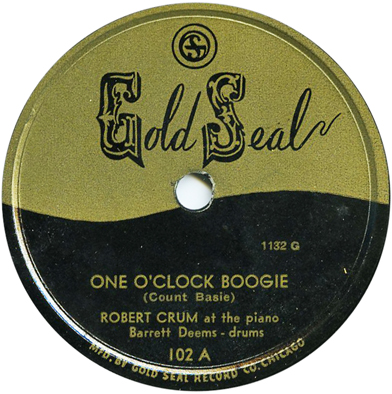
The company's first jazz series, in the 100s, was devoted to the work of pianist Robert Crum. Releases by Crum were part of the original Gold Seal announcement, so there was no connection with Green Records.
Anthony Barnett, who owns a copy of the album, has confirmed the release of a set of 3 Robert Crum 78s. Other sources have given woefully incomplete on it. Tom Lord's Jazz Discography gives the matrix numbers to just Gold Seal 103, and misidentifies the label as "Gold Star." In fact, the front album cover carries the same monogrammed seal that can be seen on the labels. The 100 series labels apportion the gold and black regions differently, but otherwise resemble those on the 400, 330, 3000/3500 and later series.
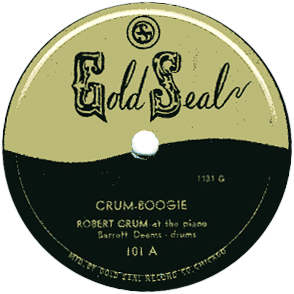
Robert Crum (p); Barrett Deems (d).
Bachman Studio, Chicago, c. September 7, 1946
| 1131 G1 | Crum-Boogie | Gold Seal 101 A | |
| 1132 G1 | One O'Clock Boogie (Basie) | Gold Seal 102 A | |
| 1133 G1 | If I Had You | Gold Seal 103 B | |
| 1134 G1 | Alexander's Ragtime Band (Berlin) | Gold Seal 102 B | |
| 1135 G1 | Who | Gold Seal 103 A | |
| 1136 G1 | The Very Thought of You (Noble) | Gold Seal 101 B |
The 3 78s were packaged into an album numbered Gold Seal P-10 on the spine, and titled Gold Seal Presents Robert Crum at the Piano on the front cover. Brief liner notes were attached to the inside front cover.
The 100s must have been the first Gold Seals to be pressed, because the border between the gold and black areas on the labels is placed differently than on any other Gold Seals that we've seen.

For high-quality audio files derived from Gold Seal 101, see the Internet Archive at https://archive.org/details/78_the-very-thought-of-you_robert-crum-barrett-deems-ray-noble_gbia0007742b.
According to Anthony Barnett, the matrix numbers carry a G1 suffix in the trail-off shellac. On the labels, the numbers are followed by a space and a G. The studio is the same one that Gold Seal would use a little while later for the first Ranch House Boys session. A session for Rondo by organist Elmer Ihrke looks to have immediately preceded this one.
We can date the session within a day or two because Crum, unfortunately, was robbed after he made it.
Robert Crum, pianist at the Forest Park hotel, St. Lous, was slugged and robbed on the north side early today, police reported. Crum, 31, said his assailant took $90, an airline ticket to St. Louis, a bundle of clothing, and a package of recordings he had made here over the weekend. He was treated for cuts and a possible concussion ("Pianist Injured When Slugged, Robbed of $90," Decatur Herald, September 10, 1946, p. 2; the AP story was dated September 9.)
Robert S. Crum was born in Pittsburgh on November 29, 1915; he was the son of Robert P. and Martha Crum. He got his piano training at conservatories in Pittsburgh and (briefly) Paris; an item in the Pittsburgh Press ("Will Study in Paris," December 31, 1929, p. 8) reported that "Bobby" Crum would be on an ocean liner out of New York harbor on January 2, accompanied by his mother. Between 1933 and 1935, he was in Hollywood, looking for opportunities to do movie scores, but got little out of the sojourn except the uncredited appropriation (or so he said) of one of his pieces by Max Steiner. Crum subsequently took a few lessons from Meade Lux Lewis, and in the early 1940s he frequently jammed with jazz musicians, pioneering a type of free improvisation. This is best described as cross-genre improvisation, because Crum, who admired Art Tatum and programmed lots of boogies, was not a jazz musician; he remained a classical performer at heart.
Crum acquired some visibility in Chicago in 1943. In mid-January, he was hired as the "afternoon pianist" at Elmer's ("Off the Cuff," Billboard, January 30, 1943, p. 19). A run of several months at Elmer's led to his being hired to play the Panther Room at the Sherman Hotel, for $300 a week starting on July 30 ("Open Field for Graduates: Films, Cafes, Theaters Hunt for Bright Combo "Students," Billboard, July 17, 1943, p. 20). The Panther Room engagement ended up stretching to 28 weeks and even included some opportunities to appear on network radio broadcasts. In August 1943, Crum appeared at a boogie-woogie concert in which he followed Forrest Sykes, his mentor Meade Lux Lewis, and Roosevelt Sykes—and was followed by Dorothy Donegan.
In early March 1944, he played the Chicago Theater and then took an engagement in New York City ("Ivory Pounders in Chips: Midwest Cocktail Pianists Skyrocket on Swooner Build-Ups," Billboard, October 2, 1943, p. 24; "New Owners for Important Chi, Balto Lounges," December 4, 1943, p. 24; "Pianists No. 1 in Chi Sector," Billboard, January 8, 1944, p. 28; "Dorsey, Krupa Set Chi Mark; Regan, Crum OK," Billboard, March 4, 1944, p. 29; Chicago Air Execs Scouting Lounges for Talent "Finds," Billboard, April 15, 1944, p. 20). Crum also appeared on a network show, the Philco Radio Hall of Fame, not long after arriving in New York, where he was working a small club called the Blue Angel. On the strength of that appearance, gossip columnist Earl Wilson even mentioned his pre-performance ritual of soaking his hands in hot water for 20 minutes (St. Louis Post-Dispatch, May 7, 1944, p. 60).
Crum is a legendary figure who left hardly any recordings behind. His duets with violinist Stuff Smith, which were privately recorded in the New York apartment of jazz fan and patron Timme Rosenkrantz in October and December 1944, didn't see release until 2002, on a 2-CD set from the AB Fable Archives. Nearly 90 minutes of lacquers by Smith and Crum were reissued on AB Fable ABCD2-004/005, Stuff Smith and Robert Crum, Complete 1944 Rosenkrantz Apartment Transcription Duets. Several solo performances that Crum made during the same run of sessions are still unissued.
A duet by Crum and Smith from a concert in New York (December 20, 1944) can be heard on another AB Fable release from 2002, ABCD2-007/008, Stuff Smith: 1944-1946 Studio, Broadcast, Concert and Apartment Performances.
Crum returned to Chicago early in 1945. Johnny Sippel caught a show at the College Inn in the Sherman Hotel: Jimmy Dorsey's Orchestra, the Dinning Sisters, Derby Wilson and Frenchy, and Robert Crum. Billboard reviewers had previously faulted him for lack of showmanship, but on this occasion, "Holdover Bob Crum seems to have found himself and is doing a good job of selling from the keyboard" (Billboard, May 19, 1945, p. 30). He appeared on Hildegarde's network radio show on two occasions in December 1945, and started a gig in his hometown, at the Tropical Bar in the Oasis Hotel, on December 24 (Harold V. Cohen, "The Drama Desk," Pittsburgh Post-Gazette, December 22, 1945, p. 14). From April through July 1946, Crum was playing solo at the New Horizon Room in the Hotel Continental in Chicago; from August 2 through 22, at the Radisson Hotel in Minneapolis (Billboard, July 27, 1946, p. 22). Klein recorded him while he was working the Forest Park Hotel in St. Louis; Crum returned to St. Louis after the session—and the robbery—and performed there for another 2 or 3 weeks.
Judging from a listen to Gold Seal 101 and 102, Crum put his boogie and stride credentials to the fore on this session. He had such a strong left hand that he could easily have recorded these numbers solo.
A reissue of these sides would be a significant addition to Crum's slender legacy; it's hard to believe, but they are the last that he made. For another year after cutting them, he remained in demand on the club circuit. In November 1946, he was back in New York for a spell, playing at the Sheraton Lounge (see Louis Sobol's column, The Evening News of Harrisburg, Pennsylvania, November 20, 1946, p. 14). Returning to Chicago, "name 88-er Bob Crum" was booked into the Silhouette, starting on March 25, 1947 ("Midwest Ops Look to Combo, Solo Talent to Chase Blues," Billboard, March 22, 1947, p. 36).
But a few months later there was a single line in the Chicago section of Billboard's "Music—As Written" (November 8, 1947, p. 22): "Bob Crum, the boogie pianist on Gold Seal, in a hospital for observation." He would never get another mention in a trade publication, and we have seen newspaper ads for just one more appearance: a two-month run at Critelli's in Des Moines, Iowa, from December 1948 through February 1949. Stuff Smith, who'd been at Crittelli's from October through December 1948, might have had something to do getting him the gig.
At the end of 1949, Crum was still performing in Chicago; the last reference we have been able to find to him as an active performer is from December 1950. Robert Crum died in complete obscurity, in Joliet, Illinois, on May 21, 1981; the obituary did not mention that he had ever been a musician.
Barrett Deems was pretty much Crum's temperamental opposite; he spent most of his life in the spotlight. Deems was born in Springfield, Illinois, on March 1, 1914, and began working professionally as a teenager. e led bands in Chicago during the early 1930s, spent seven years in Joe Venuti's group (1937-1944), then worked with Jimmy Dorsey (1945). After his session with Robert Crum, he worked with Red Norvo (1948) and Muggsy Spanier (1951-1952), before getting the call from Louis Armstrong. He spent the remainder of the decade with Armstrong's All Stars (Satchmo once said of Deems, “He makes coffee nervous”), then became a member of Jack Teagarden's last combo (1960-1964). In the 1990s, Deems was still performing weekly in Chicago with an 18-piece big band. He died of pneumonia on September 15, 1998.
The Gold Seal session is quite unusual in Deems' output. On Gold Seal 102, he accompanies Crum discreetly, largely relying on his tom-toms and his bass drum. And on the Tatumesque "Very Thought of You" (Gold Seal 101), Deems has hardly anything to do.
Gold Seal's second jazz series was in the 400s. The 400s were unusual for Gold Seal in being consecutively numbered, even though each was by a different group.

Max Miller (p); Andy Nelson (g); Buddy Nichols (b).
Bachman Studio, Chicago, September 1946
| 6 | Heartbeat [Heartbeat Blues*] (Miller) | Gold Seal 401, Life L-B-1003* | |
| 7 | Caravan (Ellington-Tizol) | Gold Seal 401, Life L-A-1003 | |
| Berta's Bounce | Green (unissued) | ||
| Tune on My Mind | Green (unissued) | ||
| Blues for Beethoven | Green (unissued) | ||
| These Foolish Things | Green (unissued) | ||
| Fantasia of the Unconscious | Green (unissued) | ||
| One Way | Green (unissued) | ||
| Sweet Lorraine | Green (unissued) | ||
| Carmen Av. Special No. 1 | Green (unissued) |
The Max Miller sides on Gold Seal 401 have an unadorned 6 and 7 for matrix numbers, suggesting that they originated from a single session away from any of the main commercial studios. We suspect that Miller, who was already used to organizing his own sessions, was in charge of this one all the way. During this period, he was using Bachman Studio on Carmen Avenue.
The Green Recordings concert program for the Civic Opera House, October 13, 1946 (see below), listed no fewer than 9 unissued Max Miller Trio items. "Heart Beat Blues" was said to be ready for "late October release"; "Caravan" was not mentioned (unless it was given some tricky retitle). "Berta's Bounce" and "Tune on My Mind" were also said to be scheduled for release in late October 1946; the others were listed as "For Future Release."
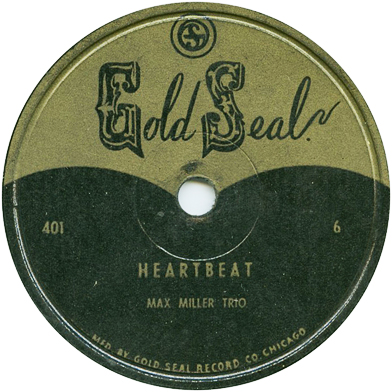
"Heartbeat" is a minor blues. "Caravan" was already a jazz standard by this time. Miller plays with such verve and power that Nelson's rhythm guitar and Nichols' bass could easily be missed by a casual listener. But Nelson's quietly insistent rhythm makes up for the absence of a drummer. When Max Miller, on his last Chicago gig, accompanied cornetist Bobby Hackett at the London House in 1959, he was given a nightly feature on "Caravan" with the rhythm section. Although the Hackett combo used bass and drums, the two 1959 renditions that have been preserved sound remarkably like Miller's Gold Seal performance.
Gold Seal 401 can now be heard in top-quality transfers at https://archive.org/details/78_caravan_max-miller-trio-ellington-tizol_gbia0003959b.
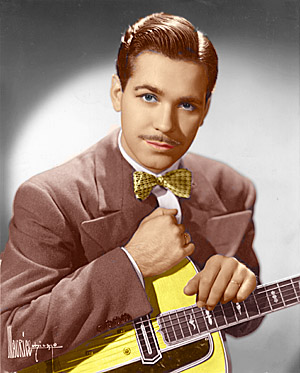
Andy Nelson was born in Harvard, Illinois, in 1921. According to his nephew, Larry Grinnell, Nelson replaced Jimmy Raney in the Max Miller Trio. Nelson said that Miller drove the other musicians in his groups hard, but that this helped him gain speed and accuracy in his playing. The Gold Seal session was Nelson's recording debut.
Nelson subsequently made a V-Disk and some Mercury sides with organist Jerry Shelton. In the early 1950s he worked with the Tune Toppers, a Cleveland-based quartet, and the Starnoters, who were affiliated with WGN in Chicago. He appeared on Leroy Van Dyke's Dot single of "Auctioneer" and "I Fell in Love with a Ponytail," and played Hawaiian guitar on organist Ken Griffin's Columbia LP Hawaiian Serenade. In 1955, he took a job with the Chicago Instruments Company, do traveling clinics and sales for Gibson guitars (till 1962), then for Epiphone (through 1965). He then took a higher-paying position with CBS/Fender. In 1970, after suffering a heart attack, he retired on a disability. When his disability pension expired in 1986, he returned to active playing in the area around Fort Myers, Florida, working with his third wife, singer Muri Graham. Andy Nelson died of heart failure on November 20, 1995, in Cape Coral, Florida. We are indebted to Larry Grinnell (email communications, November 8-9, 2012) for this bio of Andy Nelson, along with the colorized photo and information about the reissue (see below) on Life 1003.
Gold Seal failed to work out as Max Miller had hoped. Not at all. By the end of 1946, he was in California, and would not return to Chicago until well into 1948. His friend and patron Paul Eduard Miller eventually got him on board with another small Chicago label, Life Records, in 1950. Life even reissued his Gold Seal record. Miller remained with Life until it closed in 1952. And after his first recording session for Life, he got an opportunity to make a 10-inch LP for Columbia, in its Piano Moods series. The Columbia LP would become his best-known recording, by quite some distance. For Miller's subsequent career, see our Life page.
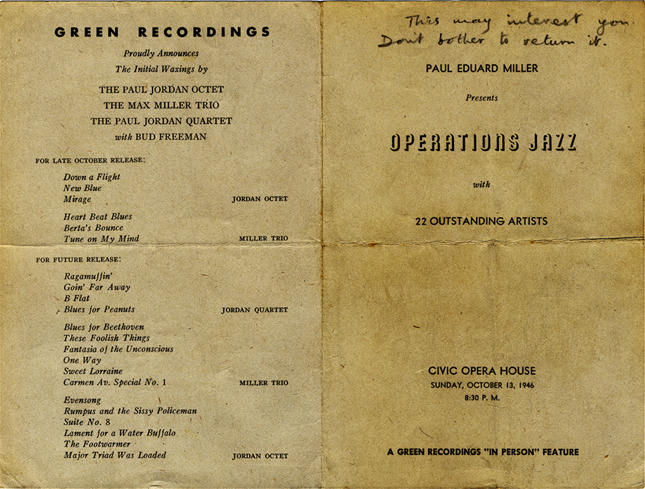
The other 400s were by two different groups led by pianist and arrangerPaul Jordan. Jordan kept a low profile during his lifetime and is no better known today. He was born in Chicago on August 25, 2016. We are indebted to Derek Coller, who has unearthed parts of the Jordan story, for most of what we can provide here. In a letter of November 28 through 30, 1987, Jordan stated, "My father was a prominent physician in Chicago, well-to-do, bright &ecaute;migré from England. Worked his way through medical school as a chemist — and so on — loved music and bought me a piano at about age 4 and so on..." (quoted in Derek Coller, "Another Unsung Jazzman: Paul Jordan — The Incomplete Story," IAJRC Journal, December 2015).
Jordan's first musical association, so far as we know, was with tenor saxophonist Floyd Town and his Men about Town. He may have been in the group in July 1933. He was definitely in it from January 1936 till the band broke up, at the end of 1938. From January through July 1936, at the Via Lago Café (837 Wilson Avenue), the lineup was Town (ts, dir); Dick Donahue (tp); Bill Dohler (as); Johnny Lane (cl); Paul Jordan (p); Norman Van Hook (b); Don Carter (d). Anita O'Day (born Anita Belle Colton in Kansas City on 1919, she took her stage name in the early 1930s) sang on occasion with the Men about Town at the Via Lago after her regular gig; Don Carter became her first husband. In January 1938, Town still had the same lineup except that Al Gold had taken over on clarinet.
What Jordan was doing between the beginning of 1939 and the beginning of 1941 we don't know. Somewhere in there he obviously came to the attention of Paul Eduard Miller, because the May 1941 issue of Music and Rhythm featured an article on him by the critic (using his real name on this occasion). Among Jordan's compositions to date, "Lament for a Water Buffalo" and "Suite No. 8" were mentioned. On October 31, 1941, while Artie Shaw was playing a one-nighter at the Chicago Theater, Jordan talked to Ray Conniff backstage and handed him some compositions and arrangements for Shaw to see. Shaw obviously liked them, because by November 17, Jordan had finished his first arrangement for the band. When Shaw returned to Chicago for a night at the Aragon Ballroom on December 29, Jordan's pieces were mentioned in the publicity. Jordan is known to have contributed 14 to the book, 9 of which were recorded. Those that Shaw put on Victor included "Evensong" and "Suite No. 8," both Jordan compositions; they were released on a 12-inch 78. Shaw, however, was having health problems, and on January 17 his doctors told him to stop touring, resulting in 6 weeks of canceled engagements ("Medicos Haul Shaw Off of Road Tour," Billboard, January 24, 1942, p. 4). The Victor sessions of January 21 and 22, 1942 were the last things this band did. Paul Jordan accomplished a lot in just over 2 months.
Two or three months later, Paul Jordan joined the band of Bob Chester, a tenor saxophonist from Detroit who had been leading bands in the Glenn Miller mould since 1939. Chester began recording for Bluebird on July 31, 1939, and was obviously in demand, cutting 5 sessions in 1939, 11 in 1940, and 12 in 1941; he was on the radio a lot, too. Jordan was hired during a period of high turnover at least partly explained by the World War II draft, after the band's second session of the year, which took place on March 4. He was on Chester's Bluebird sessions of May 27 (getting a short solo on "Strictly Instrumental") and June 30, 1942, and was mentioned in Billboard's coverage of Chester's live performances through January 1944. Jordan is also on broadcasts that have been preserved (on Joyce LP4005, Spotlight on Bob Chester and Teddy Powell) from May 12 and August 23, 1943. A positive review of the band at the Chicago Theater on August 7, 1943, noted that "Pianist Paul Jordan's composition, Footwarmer, gives composer and 15-year-old tenor sax man Herbie Stewart [sic] a good workout and rides for big applause" (the soloist was Herbie Steward; Frank Gill, Billboard, August 21, 1943, p. 22). By August 23, when a well-preserved radio broadcast caught Chester and band for 14 minutes playing for the troops at Fort Hayes in Ohio, Steward had left the band, and Chester, who announced Paul Jordan as the composer and arranger for "The Footwarmer," was the featured soloist. A review of a December 25, 1943, performance at the Orpheum in Los Angeles mentions Jordan's composition "Rollo Get with It" (Sam Abbott, Billboard, January 8, 1944, p. 26). By May 1944 Chester had put together a new band, with Teddy Napoleon at the piano, but "Rollo Get with It" was still in the book. What Jordan was doing for most of 1944, 1945, or the first half of 1946, we don't yet know.
Although his attack on the keys was quite different from Max Miller's, Jordan was also a harmonic modernist and a rhythmic Swing player. We doubt he had any objections to bitonal blues.
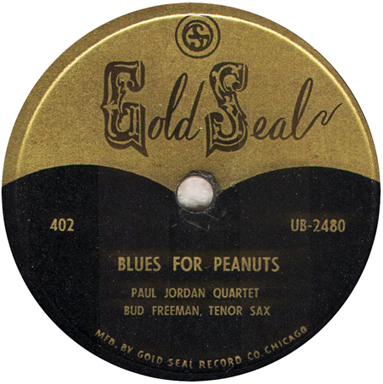
Paul Jordan (p); Bud Freeman (ts); Mike Rubin (b); Frank Rullo (d).
United Broadcasting, Chicago, September 1946
| UB-2479 | Goin' Far Away | Gold Seal 402, Classics [Fr] 975 | |
| UB-2480 | Blues for Peanuts | Gold Seal 402, Classics [Fr] 975 | |
| Ragamuffin' | Green (unissued) | ||
| B Flat | Green (unissued) |
Gold Seal 402 was by a Paul Jordan Quartet, featuring Bud Freeman on tenor saxophone. The matrix numbers from Lord's Jazz Discography have been confirmed by Bob Sunenblick and Tom Hustad. The uptempo "Blues for Peanuts" and the ballad side, "Goin' Far Away" feature excellent solo work by Freeman and Jordan and strong underpinning by Rubin; Rullo has little to do on the ballad side but can be heard to advantage on "Blues for Peanuts."
The unissued numbers were listed on the back of the Green Recordings program for the Civic Opera House concert of October 13, 1946. All four items from this session were credited to the Jordan Quartet "For Future Release."
What was probably the same group had already been recorded live at the Opera House on September 1, 1946 by John Steiner, who eventually used two tracks to fill out a Bud Freeman LP for his latter-day Paramount label, CJS105. Well, if September 1 is the correct date for the Opera House recordings... we confess to some doubts about that. The personnel we list here was taken from Lord's Bud Freeman entry, not his incomplete and confused Paul Jordan entry. (See the Green Records story, below, for more about these matters.)
Classics 975, released in France in 1997 under the title Bud Freeman 1946, is the only reissue of anything from the Gold Seal 400 series. The Paul Jordan Quartet tracks were dubbed from 78s in Tom Hustad's collection.
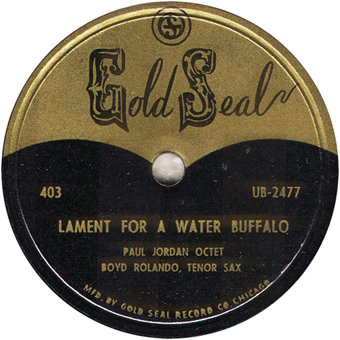
Paul Jordan (p); Bob Durfee (cl, as); Bill Dohler (as); Boyd Rolando (ts); George Barnes (eg); George Allen (eg); Mike Rubin (b); Frank Rullo (d).
United Broadcasting Studio, Chicago, September 1946
| UB-2477 | Lament for a Water Buffalo | Gold Seal 403 | |
| UB-2478 | The Footwarmer | Gold Seal 403 | |
| Down a Flight | Green 6001 (never issued) | ||
| New Blue | Green (unissued) | ||
| Mirage | Green (unissued) | ||
| Evensong | Green (unissued) | ||
| Rumpus and the Sissy Policeman | Green (unissued) | ||
| Suite No. 8 | Green (unissued) | ||
| Major Triad Was Loaded | Green (unissued) |
The two sides that Gold Seal actually put out, "Lament for a Water Buffalo" and "The Footwarmer," were not on Green Records' schedule for release in late October 1946. They were identified on the October 13, 1946 concert program as being readied for a future release. It was "Down a Flight," "New Blue" and "Mirage" that were announced for late October release, and "Down a Flight" that was inked in on a mockup label for the first Green Records release, Green 6001. The remaining sides were on the "Future Release" list. "Evensong" and "Suite No. 8" were two of the compositions that Jordan had contributed to the Artie Shaw band.
A listen to Gold Seal 403 confirms the instrumental lineup listed in previous discographies. However, on the two released sides, Bob Durfee (who gets no solos) is playing alto saxophone rather than clarinet; previous discographers didn't mention that he doubled. On both sides of Gold Seal 403, Jordan often uses two alto saxes and one tenor to stand in for the entire wind and brass sections of a larger band (it takes careful listening to recognize that no trumpet is present). "The Footwarmer," as the labels advertise, features the fleet, rather pale tenor saxophone of Boyd Rolando. The two alto saxes occasionally play background motifs during his solos. Toward the end there is a long stretch of just tenor sax and drums. Gold Seal should have credited Mike Rubin on "Lament for a Water Buffalo," which extensively features his plucking and bowing. There are brief guitar solos by George Barnes on both sides; George Allen seems to be functioning strictly as a rhythm guitarist.
The two released sides indicate that Jordan was composing and arranging in an advanced Swing style. "Lament" was already on his list of compositions in 1941. It gives much more prominence to the string bass than was the norm in 1946, and both sides make effective use of an unorthodox instrumental lineup (which must have been tough to balance in the recording studio; Rubin is somewhat recessed on his solo feature and Barnes is a bit too loud on both sides). "The Footwarmer" was written for Bob Chester's band and had previously featured Herbie Steward or Chester himself on tenor sax.
There was some variation in personnel between the recording session and the October 13 concert. According to the concert program, Jack Cavan was added on trumpet, Charlie Spero replaced Bob Durfee on clarinet, and Abe Luboff was added on bass, making what was really a tentet—with two guitars and two basses.
Bill Dohler's participation in the octet, both on the recording session and at the Civic Opera House concert, makes another connection with John Steiner's recording activities. Dohler, an alto saxophonist who never became anything like a household name, participated in a Bud Freeman session for Steiner's S D label on September 30, 1946, getting one side as a leader out of it.
Our thanks to Bob Sunenblick, Dan Ferone, and Tom Hustad for information on Gold Seal 403.
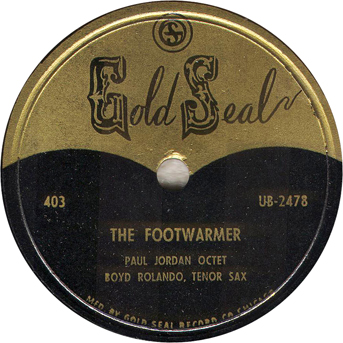
Like Max Miller, Paul Jordan could not say that his Gold Seal releases helped him get work. Down Beat (July 14, 1948) had him at the Silver Palm, a strip joint at Wilson and Broadway, with a trio. In January 1949 Jordan was still there, with Charlie Clark, tenor sax, and Ross Morrison, drums. Jordan did land one recording session toward the end of the year, with a quartet led by guitarist Gene Colin. He can be heard to advantage on "Shut Up Shut Up" b/w "Someday Sweetheart" (Rondo 218), which also include great clarinet and alto sax work by Buddy Shaw. But Rondo's labels referred to him as Paul "Gordon."
1950 was a better year. On January 5, 1950, Paul Jordan's sextet (John Carroll, trumpet; Boyd Rolando, tenor sax; George Barnes, electric guitar; Mel Schmidt, bass; Frank Rullo, drums) backed Anita O'Day on a session. Two of the four sides were released in March on London 616, but they had not been made for that company (London would sign O'Day, but not till the fall of 1950). "Blues for Bojangles" and "Your Eyes Are Bigger Than Your Heart" were both credited to one Chuck Darwin, possibly the same individual who worked as road manager for a couple of vocal groups, and a little later for Seeco and Dawn Records. It would be interesting to know where they were recorded. Supposedly the singer's microphone was malfunctioning on "Your Eyes," as well as the other two sides, which have never been released; however, O'Day sounds all right on reissues of this track. Down Beat for May 19, 1950 had O'Day at the Hi-Note with Paul Jordan, Boyd Rolando, Verne Rammer on bass, and Elmo Luperini on drums. After the singer departed, the June 16 issue put a Paul Jordan quartet there with Denny Roche, trumpet; Buddy Nichols, bass; and Guy Viverous, drums.
For more about the Hi-Note, we turn to Jack Tracy's reminiscence (Steven Cerra, "Jack Tracy, 1927-2010 - Remembering an Old Friend," http://jazzprofiles.blogspot.com/2013/07/jack-tracy-1927-2010-remembering-old.html):
A number of smaller local clubs made jazz their steady policy.
One example of such venues was the Hi-Note, a club on seedy Clark Street that was said to be at least partly financed by Anita O’Day. She often worked there, and for one stretch was co-featured nightly with Billie Holiday, singing to audiences sometimes as few as a dozen listeners. Jeri Southern got her start there, and a young Buddy Greco played solo piano and sang for maybe $125 a week.
Monday nights were “off-nights” at the Hi-Note, a chance for local musicians to come in and jam. Traveling guys would drop by to check them out and sometimes sit in. If anyone got paid I’d be surprised, but if they didn’t have gigs elsewhere you’d see Cy Touff, Ira Sullivan, Ira Shulman, Red Lionberg, Joe Daly, Hal Russell, Bill Russo, Guy Viveros, Irv Craig, Doug Mettome, Kenny Frederickson and so many others with great talent and ambitions. Some made it, some fell into the drug scene and disappeared, others stayed and played in Chicago.
Bud Freeman recalled three weeks in an East St. Louis club in 1950 with a sextet that included Jordan along with Ruby Braff (cornet). In 1952, Paul Jordan made two sides for Life with the Max Miller Quintet. There was talk of his joining a new trio led by George Barnes (with Irv Kluger as the projected drummer), but we have no evidence that anything came of it.
Jordan resurfaced in 1956 on two recording sessions done in Chicago. One for Argo (LP606, Doorway to Dixie) used a band led by bass trumpeter Cy Touff to make 6 tracks, just enough to make an LP with four Miff Mole sides from 1950 that the Chess brothers had acquired from Premium. Touff was joined by Muggsy Dawson on cornet, Mike Simpson on clarinet, and a now-familiar rhythm section of Paul Jordan, Mel Schmidt, and Frank Rullo. Jordan soloed on 5 of the tracks.
In his liner notes, Down Beat editor Jack Tracy indicated that Jordan, Schmidt, and Rullo had all been doing studio work. It would be interesting to know how much. Schmidt and Rullo had previously recorded on a Dot LP by Earl Backus, and Schmidt had been a member of two Paul Severson groups that recorded an LP for Academy and a later outing for Replica (for more about Severson, whose music was used in an independent film from 1958 called The Cry of Jazz even though his band was never seen, see our Sun Ra page). A 1964 advertisement stated that Paul Jordan had done arrangements for Pat Boone (a big star for the Dot label) and for other vocalists; we infer from this that such studio work as he obtained was probably on pop sessions.
The other LP session from 1956, The Persuasive Sax of Russ Procope, was for Dot but was clearly a Chicago product, with the leader on alto sax, Earl Backus and Remo Biondi on guitar, and Jordan, Schmidt, and Rullo again. The Dot album, which once got an LP reissue in Japan but has never been on CD, has become a sought-after rarity. The Russell Procope LP was well recorded, presumably at Universal, but the producer wanted the leader's alto sax way up front and the accompanists way in the back, which did Jordan no favors. And Earl Backus, who had already made his own LP for Dot, got most of the solo time not taken by the leader. However, Procope's "Persuasion (Blues)" is an evident derivative of "After Hours" and it also runs to 5 minutes. Jordan solos, as the pianist should, and makes the most of it.
In the early 1960s, Paul Jordan moved to Denver, Colorado. In September 1964, he was playing solo at a club in Colorado Springs called the Dublin House. The extent of the portfolio material in the club advertisement suggests that he had not been in the area too long. His second wife, Betty, died in 1986. Jordan died in 1989 at the age of 73.
The 400 series was not originally recorded for Gold Seal. Leonard Klein got the sides from a failed start-up called Green Records. Green Records was announced two weeks after Gold Seal opened for business—and lasted maybe two more weeks.
In a nutshell: Jack Green announced in October 1946 that he had recorded two artists, the Paul Jordan Octet and Max Miller. Miller, he said, had cut some original compositions on piano and some on celeste, with the assistance of Buddy Nichols on bass and Andy Nelson on guitar. These and the Jordan sides would be coming out on a label called Green Records. Except that no such thing ever happened.
What Jack Green did manage to accomplish was a fair amount of recording and a little bit of concert promotion. In its issue of October 12, 1946, Billboard ran a story titled "Real Estate - Jazz Concert Op Forms New Chi Diskery."
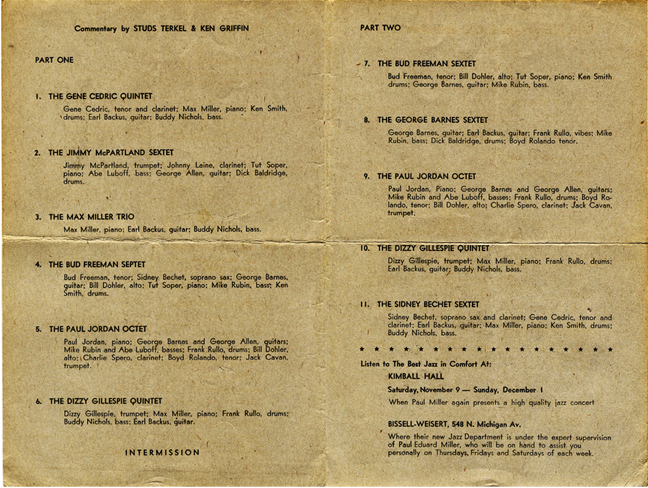
"Chi's biggest jam session ever" was planned for the Civic Opera House on October 13. "John C. Green, industrial-real estate op who dabbles in concert promotion, heads the diskery. Aided by Paul Edouard [sic] Miller, the jazz critic, he has rounded up 22 jazzmen, including Sidney Bechet, Gene Cedric [sic] and Dizzy Gillespie, who'll fly in for one-nighter, together with Paul Jordan, Max Miller Trio and Bud Freeman, latter three being stars of Green's first releases. Green plans to have Freeman Quartet, Miller Trio and Jordan's Octet do numbers at concert, which they do on first Green issues, plus other numbers by the 22 jazzists. If Green gets good reaction to any numbers on program which haven't been waxed, he plans to have John Steiner, former head of S. & D. platters on hand to record them after the show" (p. 35).
The article mentioned a follow-up concert to take place at Kimball Hall on October 26, "when Boyd Rolando, tenor find, heads a mixed group of jazzmen." The first concert took place. The second was postponed. It may have happened at Kimball Hall on November 9, as announced in the program; the next concert that Paul Miller was due to put on, on December 1, definitely did take place, but probably without any involvement from Green. The cost of the October 13 concert, including the fees paid to the guest stars and their travel expenses, had to be one reason. The cost of the recording sessions was another: Green announced that it had recorded 22 sides already (and Max Miller's "Caravan" would make 23). The Billboard story manages to explain in succinct terms why Green Records wasn't going to make it: "Green plans to confine the catalog strictly to jazz. Deal has been made for a Midwest pressery to handle disk production, but distribution problems still confront the firm."
Since Leonard Klein had until recently been an employee of United Broadcasting Studios, he was well placed to pick up unreleased sides made there,such as any items that Jack Green had recorded and couldn't put out on his own. So Gold Seal's first act of scavenging was to release three singles that Green had planned. We'll add that Klein obviously remained on good terms with Egmont Sonderling, because Gold Seal kept recording at United Broadcasting as long as it was actively recording anywhere—through the end of 1947.
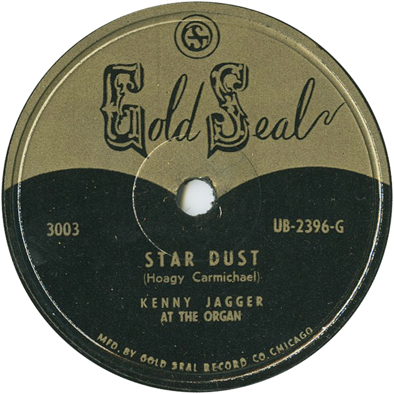
Also being recorded at United Broadcasting, even before Klein announced he was opening for business, was Kenny Jagger, who played piano and organ. Jagger's records feature him alternating between the instruments, trading piano for celeste on 3507, and occasionally adding some discreet overdubbing. At least eleven Kenny Jagger singles came out on Gold Seal, from at least two recording sessions. Maybe we shouldn't call the Gold Seal 3500s a short series.
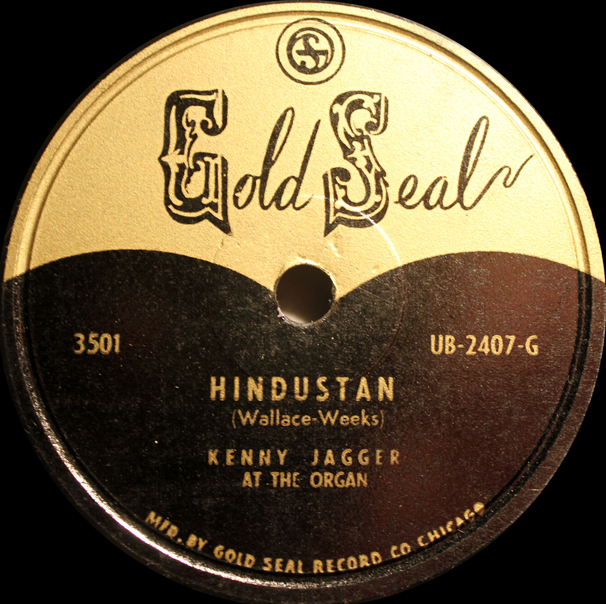
So far as we know, Jagger was the only artist in this series. It was not quite consecutively numbered, going from 3501 to 3505, then 3507 through 3510, then 3517—with a 3003 thrown in. In all, that makes 11 singles, and we still might have missed one. In due time, Kenny Jagger got a 4-pocket album, released after all of his singles were out. It had no number when it was reviewed in Billboard, and the reviewer dinged it for cheap production "could have been better with info on Jagger on pamphlet or printed inside alum [sic] cover" (January 3, 1948, p. 31).
Kenny Jagger (org, p).
United Broadcasting Studio, Chicago, September 1946
| UB-2396-G | Star Dust (Hoagy Carmichael) | Gold Seal 3003, Gold Seal album (no number) | |
| UB-2397-G | Dardanella (Bernard-Black-Fisher) | Gold Seal 3003, Gold Seal album (no number) | |
| UB-2398-G | Kiss Me Again — Waltz (Victor Herbert) | Gold Seal 3502 | |
| UB-2399-G | Begin the Beguine (Cole Porter) | Gold Seal 3505, Gold Seal album (no number) | |
| UB-2400-G | In an 18th Century Drawing Room (Raymond Scott) | Gold Seal 3504 | |
| UB-2401-G | Brahms' Lullaby (Brahms) | Gold Seal 3504 | |
| UB-2402-G | I'll See You in My Dreams (Isham Jones) | Gold Seal 3505, Gold Seal album (no number) | |
| UB-2403-G | Polonaise (Frederic Chopin) | Gold Seal 3503 | |
| UB-2404-G | Warsaw Concerto (Richard Addinsell) | Gold Seal 3503 | |
| UB-2405-G | A Kiss in the Dark — Waltz (Victor Herbert) | Gold Seal 3502 | |
| UB-2406-G | Boogie Woogie (Pinetop Smith) | Gold Seal 3501, Gold Seal album (no number) | |
| UB-2407-G | Hindustan (Wallace-Weeks) | Gold Seal 3501, Gold Seal album (no number) |
The UB 2000 numbers indicate that the sides were recorded at United Broadcasting in September 1946. Our thanks to Steve Wren for information about the final two sides. Six singles came out of the marathon session.
It's difficult to establish release dates for Gold Seal, because the company bought no ads in the trades and submitted just just two of its products (Gold Seal 3517 and the Kenny Jagger album—see below) to Billboard for review. However, a blurb in the Racine, Wisconsin newspaper (The Journal Times, February 12, 1947, p. 8) directed readers to John's Nobby Lobby to hear Kenny Jagger in person, and to Music, Inc., to buy his Gold Seal records ("priced at 79c"). Enough titles are cited to cover at least one side of Gold Seals 3501, 3502, 3503, 3504, and 3505, so we know that all of these were out by February 1947. This is the first newspaper notice we've found that refers to Jagger as a Gold Seal artist. An ad from Richard's Music Mart, in Waterloo, Iowa (The Courier, February 16, 1947, p. 14) mentions Gold Seal 3503 by titles. Jagger's Gold Seal connection would be included in future ads through September 1947—several months' worth from Racine, Wisconsin, where he obviously had a following—and from an ad in November from Eau Claire, same state.
With 3003 sitting all alone in its series for Gold Seal, we suspect it was released well after the other sides from this session. Possibly also after the sides from Jagger's second (see below). "Star Dust" was listed as Kenny Jagger title in a record store advertisement from Franklin, Indiana (The Franklin Evening Star, April 9, 1948, p. 2).

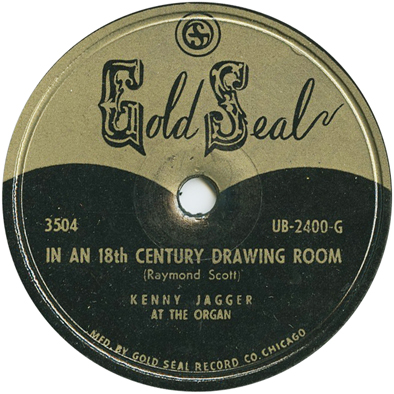
Kenny Jagger was born in Columbia City, Indiana, on December 23, 1918. While still attending high school in Rochester, Indiana, he started playing at the Colonial Hotel. He attended the Sherwood Music School in Chicago, studying theater and radio organ. He enjoyed a very long career playing organ and piano in hotels and lounges. For a time he had his own radio show on WNEW in New York City, and his own TV show on WFBM in Indianapolis; for many years, his bookings were handled by MCA. He rated an entry in the 1944 Billboard Music Year Book, where he was already identified as an MCA artist: "Kenny Jagger is one of the better known cocktail singles. Especially famous for his ability to play the organ and the piano simultaneously..." (p. 311).
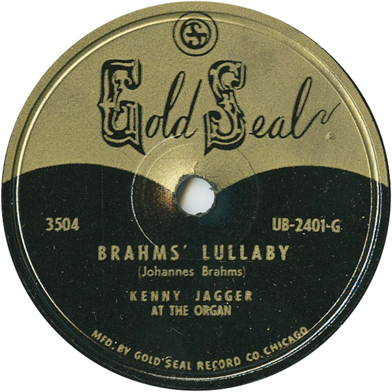

Kenny Jagger (org, p, celeste).
United Broadcasting Studio, Chicago, c. November 1946
| UB-2706-G | Twilight Time (Ram-Nevins-Bunn)% | Gold Seal 3507 | |
| UB-2707-G | Moonlight Serenade (Miller)% | Gold Seal 3507 | |
| UB-2708-G | Beer Barrel Polka (Brown-Timm-Vejvoda) | Gold Seal 3508 | |
| UB-2709-G | Friendly Tavern Polka (Brown-DeVoe) | Gold Seal 3508 | |
| UB-2710-G | Easter Parade (Berlin) | Gold Seal 3509 | |
| UB-2711-G | Softly as in a Morning Sunrise (Hammerstein-Romberg) | Gold Seal 3509 | |
| UB-2712-G | Sentimental Journey (Green-Brown-Homer) | Gold Seal 3510 | |
| UB-2713-G | Sunrise Serenade (Lawrence-Carle) | Gold Seal 3510 |
Jagger returned to United Broadcasting later in the fall. It would be interesting to know whether there was a 3506. Gold Seal 3507 let buyers know that he was also playing celeste. 3508 and 3509, unlike his earlier Gold Seals, let the purists know that he also played piano. An ad from Franklin, Indiana, in April 1948 (The Franklin Evening Star, April 9, p. 2) mentions one title each from Gold Seal 3502, 3503, and 3003, and both titles from 3505. It also mentions "Moonlight Serenade" (3507) and "Sunrise Serenade" (a title, as it turns out, from 3510). It throws in "Anniversary Song," which was either a title from still another Gold Seal, or a title recorded for another label.
We have learned of one more Kenny Jagger single: Gold Seal 3517, with "Tschaikowsky's Piano Concerto" on one side and "Grieg's Piano Concerto" on the other. These, of course, would have been 3-minute arrangements of the introduction to the first movement of Tchaikovsky's Concerto No. 1, plus maybe another theme, and of a couple of themes from Grieg's concerto. We would like to see a copy, to verify the release number among other things. Both sides of 3517 were included in Gold Seal's Kenny Jagger album (Billboard, January 3, 1948, p. 31), and cited, by number, in Billboard's new release announcement for the album (same date, p. 30).
There was a weirdly delayed announcement of Jagger being "pacted" with Gold Seal—in Billboard for April 26, 1947 (p. 22). By then he was done with his two sessions for the company, and had had time for a third —we haven't seen the matrix numbers on the concerto theme record, which might have been cut at a third session. Jagger was regularly advertised as a Gold Seal artist during 1947, but income from personal appearances made the sales of his records relatively unimportant. Stores were still offering his Gold Seals in 1948, but notices about his appearances, even when they still proclaimed him a recording artist, were no longer mentioning Gold Seal.
Supposedly Jagger's most popular record was his rendition of Pinetop's "Boogie Woogie." His performance on Gold Seal 3501 is impressive, miles removed from the cornball rendition of "Hindustan" on the flip. But the single is hard to find today—we know of two copies—making us wonder how popular it really was. But here was the news from Owensboro: "STAN LAMBERT, local jukebox operator, reports that the disc enjoing the greatest play on several of his machines is PINE TOP SMITH'S BOOGIE WOOGIE as played by KENNY JAGGER and featured at INTERSTATE" (LeRoy Woodward, "Platter Chatter," The Messenger-Inquirer (Owensboro, Kentucky), February 23, 1947, p. 12; the column promoted Interstate Records).
After his Gold Seal days, Jagger cut a few more singles (we presently know of three) for fm, a small company based in Los Angeles. These are at least as obscure as the Gold Seals. The fms were most likely recorded in the first quarter of 1949. An ad for organ records available from Blake Home Appliance, on North State Street in Marengo, Illinois (Marengo Republican-News, April 7, 1949, p. 13) mentions three Kenny Jagger titles we don't recognize from his Gold Seal days. "Cherokee" was the A side of fm 340 (with "Marie" on the flip), so we are reasonably confident that "Sleepy Time Gal" and "Josephine" came off two other fm releases. The Southern California fm should not be confused with future Music or f. M., which was a short-lived Chicago-based label roughly contemporaneous with Gold Seal. It should also not be confused with several later FM operations.
We don't know whether Kenny Jagger ever walked into another recording studio after his time with fm. He just kept going with club and hotel work, not to mention radio and TV. Jagger started the Indianapolis BMW Motorcycle Club and worked to promote a positive image for his hobby; he eventually received an award from the German manufacturer for riding more than 300,000 total miles on its motorcycles.
He died in Indianapolis on Feburary 9, 2010, at the age of 91. (See the commemoration at http://olioscourge.blogspot.com/2010/02/godspeed-kenny-jagger.html.)
Meanwhile, harking back to the company's first press release, Billboard announced (December 28, 1946, p. 29) that Arthur Lee Simpkins' first Gold Seal 78, coupling "Ol' Man River" and "Begin the Beguine," would appear on January 10, 1947. As will be seen below, both songs were frequently featured during the singer's live performances. The single is maddeningly elusive. We know it was advertised for sale (Richard's Music Mart, in Waterloo, Iowa, carried it in June 1947—among "Record Favorites of Yesterday"; see The Courier, June 25, 1947, p. 3) but we know nothing beyond the the two titles and have yet to see a copy.
Arthur Lee Simpkins was born in Augusta, Georgia, on August 18 or 20, 1907 (depending on whether you consult the Social Security Death Index or the California Death Index; his draft registration in 1940 said August 18). He was the son of Alex and Emma Simpkins. Arthur Lee received a lot of Classical vocal training. In the 1930 census, he still residing in Augusta. His occupation was said to be "bank porter" and he had been married for four yours to Aurora M. Simpkins, who was born on December 3, 1903. By 1932, he was already traveling northward: The Simpkins Brothers, featuring Arthur Lee Simpkins were on Popular Tunes in Popular Rhythm, at 12:30 AM on WJZ in Brooklyn (Brooklyn Times Union, May 7, 1932, p. 18). His younger brother Willie, born around 1917, completed the ensemble. In 1933, Simpkins led a band called the "Augusta broadcasting" Night Hawks; they appeared at the segregated Elks hall in Greenwood, South Carolina ("Augusta Orchestra at colored Elks Hall," The Index-Journal, May 26, 1933). On August 4, 1933, his band (not specially named this time) played a dance at the official opening of the Civilian Conservation Corps camp in Montmorenci, South Carolina ("Barbecue and Dance Lead Entertainment, Aiken [SC] Standard, August 11, 1933, p. 2). At some point during the next year, he sang with Earl Hines' big band, then briefly led a big band of his own.
On his first known recording, made for Victor in 1936, Arthur Lee Simpkins was the vocalist on "Sing Sing Sing" for the Fletcher Henderson Orchestra ("Sings with Henderson," Chicago Defender, August 22, 1936, p. 15, mentioned him appearing with Henderson at the Grand Terrace, which meant NBC radio broadcasts with the band). In those days he was billed as "Georgia Boy." Simpkins would continue to be based in Chicago for a number of years; his Social Security Number was issued in Illinois.
Although he offered a Chicago address as one of three on his draft registration (signed on October 16, 1940), Simpkins was in Harlem for the 1940 census. In 1944, Billboard reviewed his appearance at the Latin Quarter in New York City, where he was headlining a show, backed by Don McGrane's house band. The reviewer, inaccurately calling Simpkins a tenor (he was a baritone; the frequent misidentification stemmed from his operatic delivery and his high notes), declared that he "knows how to sell a song with the best of 'em." Simpkins sang "Because," followed by a "jump version" of "Begin the Beguine," "Pagliacci," and "Eili Eili" ("Latter sounds like corn but Simpkins delivered it with such dramatic effect that traditional Hebrew chant sounded new"). For an encore, he did "Alouette" with much audience participation (Bill Smith, Billboard, September 30, 1944, pp. 26, 31). "Lad has an infectious grin," Smith wrote (Simpkins was 36 years old at time).
Billboard reviewed Simpkins again, when he headlined a show at the Latin Quarter in Chicago on August 14, 1946, right before he was signed by Gold Seal:
Simpkins began with a sock rendition of Road to Mandalay. His next was Donkey Serenade. He is just as much a performer as a singer. Offerings range from an aria from Aida to a jive version of Old Man River. Simpkins went international and offered the Irish Cockles and Muscles [sic], the Hebrew Eli Eli [sic] and numbers in Russian and French. He was mitted back time and again and each time rewarded them with a solid rendition of whatever he attempted. (August 24, 1946, p. 40)
Simpkins didn't stick around Chicago after his Gold Seal release. On the announced date, he was either in New York City or on his way there, for a long run at the NYC Latin Quarter. He was also supposedly going to be in a film, though nothing came of that. By year's end he had recrossed the country and was in Southern California.
By 1948, Arthur and Aurora Simpkins were residing in Los Angeles. From his new home base, he was landing gigs in Las Vegas; the Pittsburgh Courier (June 26, 1948, p. 22) announced that he had just opened a four-week engagement at the Flamingo. He was photographed with Duke Ellington and Ed Sullivan, who had just talked both of them up in his newspaper column. Now Simpkins tried a lot harder to get into movies. Such opportunities were limited. Simpkins was "discovered," not by a mogul, but by a wheeler and dealer named Kroger Babb, whose Hallmark Productions (no connection with the greeting card company) was responsible for exploitation features such as Mom and Dad (1945) and Wild Weed (1949). Arthur Lee Simpkins duly made an appearance in Secrets of Beauty, a 1951 release sometimes retitled Why Men Leave Home (see http://www.imdb.com/title/tt0228830/). By the time it was released, the Babb operation was sputtering; the two other movies in which Simpkins was slated to appear were never finished. The singer's last film was an 18-minute entertainment reel that featured him along with pop singer Giselle McKenzie and other performers, performing for the troops at the San Diego Naval Training Base. Titled Camp Jamboree, it was released in October 1953.
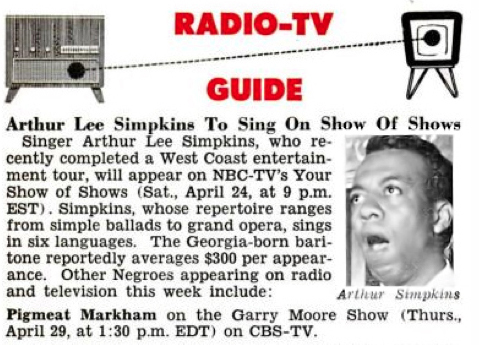
In 1950, Simpkins appeared on the early TV variety show, You Asked for It. He sang scales to demonstrate his big range, then performed "Marie" (a standard that he obviously liked, and recorded commercially at least twice) and an Italian aria with accompaniment by a studio big band. He was said to be able to do everything from Swing to opera, but these performances prove that, had he been born in a later generation, Arthur Lee Simpkins would have made a name for himself in song recitals and productions of Verdi and Mascagni. His segment can be seen online at http://tesla.liketelevision.com/liketelevision/tuner.php?channel=780&format=movie&theme=cartoons. On April 24, 1954, Simpkins appeared on the famous live TV series, Your Show of Shows.
Simpkins never would become a household name, but he did get a few opportunities to record after his Gold Seal stint. In 1950, Kroger Babb, who it seems genuinely admired his vocal skills, tried to parlay Simpkins' appearances in his exploitation flicks into record sales; he put out a 4-pocket album on a short-lived Hallmark label, emphasizing the songs of faith and inspiration. Among these was "Eili Eili," which Babb also didn't know how to spell. After the Babb operation collapsed, Simpkins made a few singles, eventually collected into a 10-inch LP of standards, for a little label called Crystalette (initially quartered in Long Beach, California, Crystalette had moved to Hollywood by the time it produced the LP). Despite the studio-band production, sometimes including an organ or a string section, Simpkins can be heard to advantage on his Crystalette sides. His rendition of "Marie" (in the uptempo middle section) show that he could swing pretty hard when he felt the need to. Simpkins also made another recording of "Eili Eili" with Norrie Paramor and his Orchestra for Columbia (we are still trying to nail down the date on that one). The flip was a Swing number, "I Hear Angels Singing."
In 1954, Simpkins made a brief return to Swing bands, when he was featured with one of the last that Earl Hines would lead. He was an audience favorite when Hines opened at the Crescendo in Hollywood ("'Fatha' Hines Debuts," Cash Box, July 10, 1954, p. 23). He probably didn't stay with the band once it left greater Los Angeles.
During the 1950s, Simpkins frequently performed in Las Vegas. Barney Rawlings, who worked as a singing MC at the Last Frontier and the Thunderbird from 1947 till 1955 or 1956, recalled the singer in a 1996 interview: "You'd probably say 'who'?" Rawlings said. "But he was a beautiful tenor who, whenever he played Vegas, filled the house. How big was Arthur Lee Simpkins? Liberace and Joey Bishop opened for him—that's how big he was" (Ed Koch, "The Singing Emcee," Las Vegas Sun, August 24, 1996, http://www.lasvegassun.com/news/1996/aug/24/the-singing-emcee/)
Although he was now a permanent resident of Los Angeles, in 1955 Simpkins began an affiliation with a bush-league record company called Miranda, based a long distance away in Lexington, Kentucky. We presume he met H. I. ("Hi" or "Hep") Miranda, the owner, during one of his engagements at the Beverly Hills Country Club, a swanky establishment in Southgate, Kentucky, just across the Ohio River from downtown Cincinnati. Simpkins had already been receiving top billing there for some years; for instance, on March 11, 1950, he launched the club's new season (it was customarily closed in January and February), headlining the show for two weeks (Billboard, March 18, 1950, p. 44). Simpkins released one single on Miranda in 1955, two in 1956, one in 1957, and another in 1960.
See Cash Box, January 19, 1957 (p. 12) for a review of Miranda 4-56-13. The trade paper reported (February 16, 1957, p. 40) that "H. I. (Hep) Miranda" was in Chicago promoting his label, and had picked up All-State Distributors. Cash Box didn't seem aware of any Miranda releases prior to 4-56-13.
In 1957, 6 tracks off Simpkins' singles and 6 newly recorded items were collected on a 12-inch LP that the company went to the trouble of releasing in stereo; the LP was variously numbered 5657 and 1917 in mono, 4017 in its stereo manifestation.
The same album would become the subject of an odd story in Billboard, which occasionally liked to inspire its readers in the music business with tales of miraculous sales. On February 23, 1959, Simpkins, then on another long engagement at the Beverly Hills, appeared as a guest on Ruth Lyons' 50-50 Club. Lyons hosted the first successful daytime talk show, first on WLW radio and then, for many years, on WLW-TV out of Cincinnati. Headliners from the Beverly Hills often sat on the couch. Simpkins mentioned his Miranda LP and its disappointing sales, then sang a few numbers from it (hardly a stretch, for such tunes as "Diane" were fixtures in his repertoire). As soon as the show was over, the station's switchboard lit up with inquiries about the album, which WLW referred to local music stores, which in turn asked Ike Klayman, the distributor, who, in turn, asked Hi Miranda, the label owner. Having just had 500 more copies pressed, Miranda delivered them to Klayman, who got them out the door and sold in four days. Klayman figured he could have moved 5000 of them (Billboard, March 2, 1959, p. 4), though we don't know whether he got an opportunity to find out. Simpkins' 1956 recording of "Them There Eyes," also included on the LP, again shows how hard he could swing when he felt the need. The Miranda productions, though also variable, went somewhat heavier on the schmaltz than the Crystalettes had been.
The Miranda LP traded heavily on Simpkins' longstanding affiliation with the Beverly. A second Miranda LP was recorded live at Beverly Hills Country Club and featured the club's MC, as well as the house band led by Gardner Benedict. The album reveals that the band was in the habit of playing "Vesti la giubba" to announce Simpkins' entrance. All of this came to an end when the Beverly Hills Country Club closed on December 31, 1961. Long controlled behind the scenes by mobsters, the club derived much of its revenue from illegal gambling. After Kentucky authorities put a stop to the gambling, the Beverly was able to limp along for just a few months. (A successor, the Beverly Hills Supper Club, operated on the site from 1969 until May 28, 1977, when it was completely destroyed by a fire that killed 165 people. Today the location is occupied by a memorial to the victims.)
A brief item in Jet (March 10, 1960, p. 28) noted that Simpkins had recently performed to "a thunderous ovation" at a Shriner's benefit show in Los Angeles, had taken a three-week vacation, and was en route to a gig in Miami, where he appeared regularly and got favorable writeups in the newspapers. During the 1960s, Simpkins continued to work fancy supper clubs and hotels in the United States and Europe. At Sam Cooke's funeral, which took place at Mount Sinai Baptist Church in Los Angeles on December 17, 1964, Lou Rawls and Ray Charles were among those making vocal tributes. In his biography Soul of the Man: Bobby "Blue" Bland, Charles Farley writes, "Arthur Lee Simpkins, a classically trained baritone and old Chicago friend of Sam's, sang 'I've Done My Work.' Bobby Bland temporarily suspended his tour to attend the service and fervently sung 'I'm Coming Home Now Lord'" (Jackson: University Press of Mississippi, p. 127). Simpkins died on January 6, 1972, a few months after a bladder operation from which he seemed to be making a strong recovery (see the news item in Jet, February 3, 1972, p. 57). He was 64 years old. Aurora died in Los Angeles in November 1976. (Our thanks to the late Eric LeBlanc for identifying birth and death dates for Arthur Lee Simpkins, and to Marv Goldberg for census and draft registration information, among other things.)
Around the time that it was bringing Kenny Jagger back into the studio, Gold Seal took up another genre. A story dated November 23, 1946, "Yank Folk Disks to S. Africa" declared that 10,000 "hillbilly" records were already en route to South Africa. Gold Seal had recorded the Ranch Boys, "folk artist octet culled from local radio crews." Leonard Klein said that further sides were planned by "South African entertainers who have migrated to the U. S." (Billboard, November 30, 1946, p. 35).
We have seen nothing on Gold Seal by any South African expatriate. But the Ranch House Boys (Billboard inadvertently truncated their name) did release a single around this time. It was the first in a 330 series for Country music.
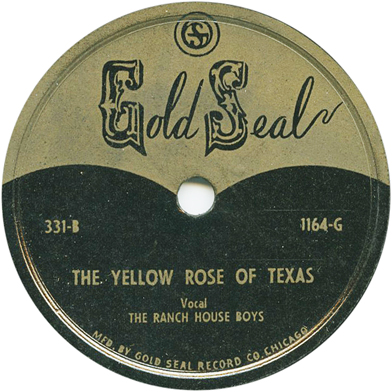
Unidentified (g, voc); unidentified (g, voc); unidentified (mand, voc); unidentified (b, voc); other unidentified vocalists may be present.
Chicago, October 1946
| BA 1164-G | The Yellow Rose of Texas | Gold Seal 331-B | |
| BA 1165-G | Down in the Valley | Gold Seal 331-A |
In the trail-off area, each matrix number is preceded by a lightly scratched BA. The matrix numbers appear to come from the same studio where the Robert Crum sides were recorded. It further looks to be the same studio used during the summer and fall of 1946 by such small labels as Hy-Tone, Sunbeam, and Rondo. This appears to be the Bachman Studio on Carmen Avenue.
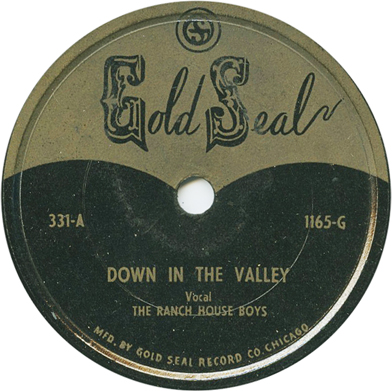
Gold Seal 331 got some circulation; none of the label's releases is easy to find today, but the first Ranch House Boys 78 does occasionally crop up. Who knows—maybe some copies made a return trip from South Africa. From what we are able to hear on Gold Seal 331 (audio also available from https://archive.org/details/78_the-yellow-rose-of-texas_the-ranch-house-boys_gbia0007146b), the Ranch House Boys were probably not an octet. The instrumentarium solds like two guitars, a mandolin, and a string bass. The vocals are sung in harmony, but whether some participants sang and didn't play we of course don't know.
We haven't encountered other Gold Seal Country releases from 1946, nor have we detected any recording activity at all between December 1946 and October 1947. But Gold Seal's interest in the "folk" market definitely perked up in October and November 1947, when it bought a bunch of sides from the defunct Bel-Tone operation (see below) and undertook some new recording of its own.
Three late 1947 releases were again credited to the Ranch House Boys. Not the same lineup as on 331, but the group was again drawn from the ranks of Country and Western DJs in Chicago.
The first new Ranch House Boys session, featuring Eddie Johnson, produced four sides, with original tunes on two of them. Not showing much regard for consecutive numbering, the company released them as Gold Seal 330 and 333.
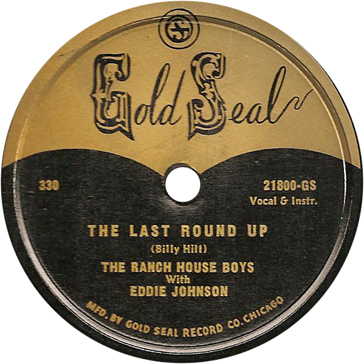
Eddie Johnson (voc); unidentified (steel-g, voc); unidentified (g, voc); unidentfied (b, voc).
United Broadcasting Studio, Chicago, c. October 17, 1947
| UB21800-GS | The Last Round Up (Billy Hill) | Gold Seal 330 | |
| UB21801-GS | San Antonio Rose (Bob Wills) | Gold Seal 330 | |
| UB21802-GS | You Cooked Your Goose with Me (Billy Fairmann-Ken Nelson) | Gold Seal 333 | |
| UB21803-GS | Bats in Your Belfry (Billy Fairmann-Ken Nelson) | Gold Seal 333 |
On December 20, 1947, Billboard reviewed Gold Seal 333 (p. 104). The reviewer was lukewarm about "Bats in Your Belfry" and "You Cooked Your Goose with Me," though appreciative of the "echo chamber" put to use on "Bats" (there is noticeable reverb on the phrase "Bats in your belfry"). Matrix numbers and label information on Gold Seal 333 are from a copy in the collection of Robert L. Campbell. Information on Gold Seal 330 is from a copy in the collection of Bill Sabis; see also https://archive.org/details/78_san-antonio-rose_the-ranch-house-boys-eddie-johnson-bob-wills_gbia0007800b.
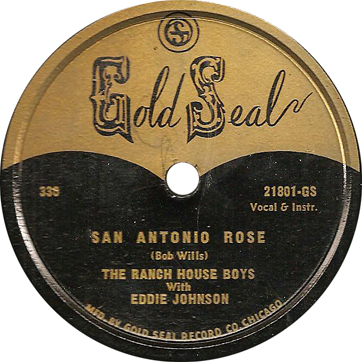

Randy Blake (voc); others unidentified.
United Broadcasting, Chicago, c. November 19, 1947
| UB22106GS | Howdy Friends, Good Evening Neighbors (Randy Blake-Ken Nelson) | Gold Seal 336 | |
| UB22107GS | The Little Golden Locket | Gold Seal 336 |
A week earlier, the December 13 issue of Billboard announced that "Randy Blake, who has the daily Suppertime Frolic, biggest Chicago folk music record show, has recorded his voice on an original song, Howdy Friends, Good Evenin', Neighbors, which is the theme of his show. Blake, who is heard over WJJD, wrote the lyrics, while Ken Nelson, station musical director, did the melody" (p. 102). Healy notes that Nelson later became an A&R man for Capitol Records and that Blake continued at WJJD into the 1950s
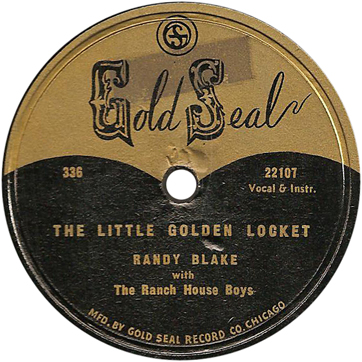
Blake's single was released as Gold Star 336. The United Broadcasting numbers indicate a recording session around November 19, 1947. On January 3, 1948, Billboard announced (p. 91) that Blake's record had sold (well, all right, it had shipped) 5,000 copies.
Were there any Gold Seal recording sessions after Blake's? Maybe not, but two more sides by accordionist Al Piazza were cut immediately after Blake's outing, most likely at the same session. Whereupon the company seems to have thrown in the towel, with 5 weeks to go before the impending recording ban.
Al Piazza (acc); unidentified (steel-g); unidentified (g): unidentified (b).
United Broadcasting, Chicago, c. November 19, 1947
| UB22108GS | Springtime Polka | Gold Seal 337 | |
| UB22109GS | Westphalia Waltz (Collins) | Gold Seal 337 |
Gold Seal 337 couldn't have sold a whole lot. We learned of it in November 2017, from the Internet Archives site (https://archive.org/details/78_westphalia-waltz_al-piazza-and-his-quartet-cotton-collins_gbia0003158b). "Springtime Polka" resembles the fare being recorded by Lee Monti for Aristocrat and a slew of polka bands for Rondo; the waltz side, on the other hand, has a prominent steel guitar solo.
In November 1947, Gold Seal recommitted itself to the Country market, in more ways than one. Billboard for November 8, 1947 ("Gold Seal Push in the U. S.; Buys Laine, Wayne, Stone Wax," p. 36), coyly noted that "the firm is pretty well set for the impending was stoppage, having purchased a supply of 300 masters from a defunct West Coast waxery whose name Klein would not divulge." "Folk" sides were mentioned, but "Bulk of the material is standards," including items by Frankie Laine and Artie Wayne. A week later, the "American folk tunes" section of Billboard put it this way: "Gold Seal records going in for hillbilly and Western catalog, utilizing masters from a defunct West Coast waxery, including sides by Cliffie Stone, Eddie Dean and Dale Evans" (November 15, 1947, p. 102).
The identity of the waxery was no mystery to anybody who'd been reading Billboard for a year or two. The defunct operation was Bel-Tone, a label that had been active in Los Angeles for 16 months in 1945 and 1946. Bel-Tone opened for business in late July 1945. Its formation was announced in a Billboard story on July 28, 1945 (p. 19). Dick Elwell, "ex-radio and booking figure from Chicago," was identified as the general manager, and "Jack Elliott, a songwriter, will handle talent." Although the story noted that Bel-Tone had acquired a recording studio from Fitzpatrick Travel Talks, this presumably was for demos and rehearsals; it wasn't big enough to accommodate some of the ensembles that the label was interested in. The company is known to have used two or three of the established commercial studios in Los Angeles.
Events unfolded quickly thereafter. Extensive Country recording took place in the first month after the company opened its doors, and jazz sessions would follow during the last quarter of 1945. Recording continued through the first quarter of 1946 but tapered sharply after that, and in June 1946, the company got its last new release listed in Billboard. The man who had been responsible for most of the company's Country sessions, Cliffie Stonehead, jumped ship to Capitol during the summer (he was recording for his new label by August 1946). Any new activity past June of1946 was either in pop sessions or "kidisks"; a new label style, which was adopted for the company's last few months, is the only one seen on the children's records. Bel-Tone filed for bankruptcy in late November 1946, owing $40,000. The company's debts included $5,000 to the Musicians Union, $2,000 to Monarch, its pressing plant, $5,000 to music publishers, and $3,000 to its artists. Since the masters were already mortgaged, these creditors must all have taken a close haircut (Billboard, December 7, 1946, p. 16).
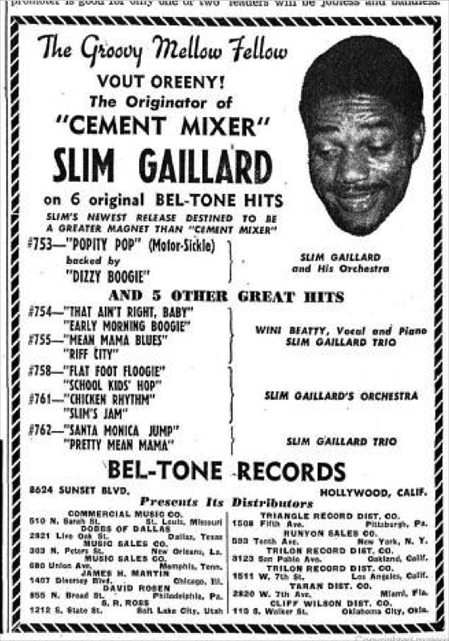
Bel-Tone's 0250 series started with S-0255 and S-0256, which were in a jazz/pop vein, then made a firm switch of genre to Country and of prefix to E-0257; then when it got to 269, it shed its prefix and initial 0. The E prefix may have stood for Elliott, but, just to confuse matters, he was already around for the S series; both sides of one version of Bel-Tone S-0255 give Jack Elliott composer credits. Bel-Tone 277 by Dale Evans was the last in this series.
Bel-Tone started three other release series: the J750s, the 2000s, and the 7000s. The company's jazz and R&B were in the J750 (later just 750) series, which Gold Seal didn't get. One of the Slim Gaillard sessions in the 750s included a couple of guests named Charlie Parker and Dizzy Gillespie, so other companies moved quickly to acquire them. The Slim Gallards were grabbed up right away by Majestic, which had them all in print again in a special 9000 series before 1946 was out. After Majestic went out of business in 1949, the entire run of Slim Gaillard Bel-Tones was reissued on a 12-inch LP in 1957, by Halo (a company run by Eli Oberstein on which he parked items of questionable origin, including other sides abandoned by Majestic). We don't know exactly when Herman Lubinsky bought them—not necessarily after the Halo release—but they appeared on Savoy LPs later on. Gold Seal passed up the offerings in the 750s by Bob Mosely and Alton Redd (apparently nobody else wanted them either). The 2000 series, all of two singles, was devoted to Latin music. The 7000s, recorded from the end of 1945 into the middle of 1946, were intended as a pop series, but 4 of the 12 releases were by Valaida Snow.
When last heard from, Dick Elwell of Bel-Tone was planning a series of "kidisks," as Billboardliked to call them, in albums. These would be done with the assistance of various voice actors and Raymond Joel Sanns' 22-piece orchestra (June 29, 1946, p. 39). We have learned of four 78-rpm albums of children's stories that resulted from this effort: Jump Jump with The Ugly Duckling (album BT-1, a 2-pocket special)Jump Jump and Sleepy Slim the Lion (BT-2, 2 pockets), Jump Jump / The Little Lost Star (BT-6, 3 pockets), and The Fisherman and the Flounder / The Elves and the Shoemaker (Bel-Tone BT-4, a 3-pocket album; only this last actually used Raymond Joel Sanns and Ork). All told, there appear to have been six albums. The kidisks all used a new label design tht the company adopted in June or July of 1946, and a new matrix series, prefixed BTAL for Bel-Tone ALbum. The kidisk series may have been intended to compete Sonora's, which relied heavily on radio children's show host Uncle Don Carney but added some staged and scored productions with professional voice actors. On BT-4, the narrator goes as Uncle Bob... We are not aware of any reissues of these items, on Gold Seal or elsehwere.
At the end of the company's run, a few 750 and 7000 series singles used the same label design that had been rolled out for the kidisks. We have seen one from the 750 series and four 7000 series 78s with the new design; they look to have been the tail end of their their series (765, and 7009 through 7012). We have not seen an (0)250 with the new design.
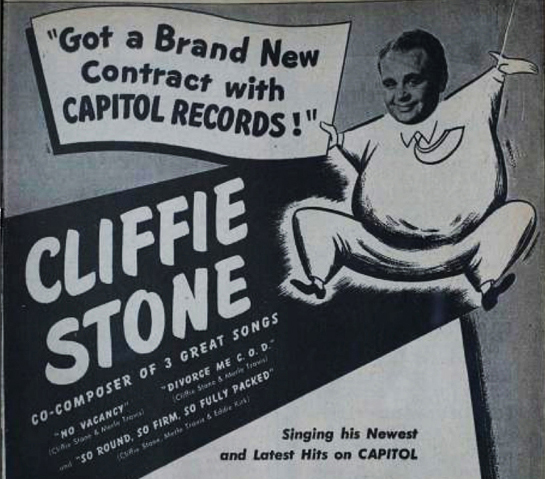

Before Gold Seal bought a bunch of 0250 and a few 7000 series masters, there'd been some developments that the company expected to take advantage of. First, Dale Evans had moved on to Majestic Records. Second, in the summer of 1946 Cliffie Stonehead had left a small role at Bel-Tone for a much bigger one at Capitol, and made one of the smarter name changes in showbiz history: he would now be going as Cliffie Stone. Merle Travis had also made a move to Capitol, where he too was racking up hits (now using his real name). Third, singer Frankie Laine, whose first sides under his own name were made for Bel-Tone, had signed with Mercury in August 1946 and scored a big pop hit.
Cliffie Stone was born Clifford Gilpin Snyder in Stockton, California on March 1, 1917, and never legally changed his name. He was the son of Clifford Herman and Nina Belle Snyder, and was raised in Burbank, California, where the family moved when he was five years old. They ran a nursery and a kennel on 5 acres. Clifford Herman Snyder had mastered several instruments, but became known as a banjo-playing comedian who sported a long beard and went as Herman the Hermit. The son adopted Stonehead as a stage name when he began doing radio work, so he wouldn't have to present himself as Herman the Hermit Junior.
Cliffie Stonehead began his professional career playing string bass in the band of Stuart "King Cowboy" Hamblen. He then spent some time in the Swing-oriented bands of Anson Weeks and Freddie Slack, cutting his first studio recording for Slack in 1942, for a brand-new label called Capitol. In 1945, he began working as a disc jockey at KPAS (later KXLA and KRLA) out of Pasadena, California. He also did a bunch of work for Bel-Tone, most likely working with Jack Elliott to organize every Country session for the label. It was on the strength of his Bel-Tone sessions that Capitol decided to bring him in. Bel-Tone responded by reissuing some of the records he had played on, name change duly noted.
Capitol hired Stone as an A&R man, though he also led the studio band and played bass on many of the records, and made occasional sides as a leader. Stone brought some big names to the label, including Les Paul and Tennessee Ernie Ford (he was Ford's manager for 10 years). His show, first known as the Dinner Bell Roundup and later as the Hometown Jamboree, enjoyed a run of more than 20 years, first on radio and later on TV. After winding up the TV show, Stone briefly operated a record company called Granite. In 1989, Cliffie Stone was inducted into the Country Music Hall of Fame and received a star on the Hollywood Walk of Fame; in 1991 he published a book about songwriting. He died of a heart attack in Santa Clarita, California, on January 16, 1998.
For biographical information on Stone we are indebted to http://knowotr.blogspot.com/2010/04/cliffie-stone-1917-98.html; to http://allmusic.com/artist/cliffie-stone-p24833/biography; to Myrna Oliver, "Cliffie Stone; Host of 'Hometown Jamboree," Los Angeles Times, January 21, 1998 (http://articles.latimes.com/1998/jan/21/news/mn-10679); and to Paul Wadey, "Cliffie Stone," The Independent, February 6, 1998 (http://www.independent.co.uk/news/obituaries/obituary-cliffie-stone-1143121.html).
Eight Gold Seal Country releases have been definitively identified as originating from Bel-Tone. Once Bel-Tone was fully launched, its master number series was rather simple in concept: it started at 01 and ended at 113. The two or three digits were prefixed with a B or a BT, usually the latter. Occasional single-digit suffixes look like take numbers.
According to Bob Healy in the IAJRC Journal Discographical Forum (DR/198, September 2010, http://www.faqs.org/periodicals/201009/2101664561.html), "Tex Travers" (a pseudonym for Merle Travis) with the Cliffie Stone Orchestra and the Sunshine Girls were responsible for "Cool Water" (BT-01) and "Hominy Grits" (BT-17-2) on Gold Seal 1701. Gold Seal felt no commitment to the couplings that Bel-Tone had used, but then Bel-Tone had already reissued some of its own sides with different couplings.
Gold Seal, in turn, had the, umm, unique idea of numbering these items by conjoining the Beltone matrix numbers for each side. So the first Tex Travers came out as Gold Seal 1701.
The first "Tex Travers" Gold Seal was, in part, a reissue of a reissue. One side had actually been recorded for Cliffie Stonehead's own Lariat label, then reissued on Bel-Tone when he started working for that operation.
Since Gold Seal made only sporadic use, on the releases that we know of, of Bel-Tone sides by Merle Travis, this is as good a place as any to introduce him. Born in Rosewood, Muhlenberg Country, Kentucky, on November 29, 1917, Merle Travis took up the guitar as a boy. He learned the local fingerpicking style and made his own elaborations on it, also listening to records by Blind Blake. At 18, he performed on a radio amateur show in Evansville, Indiana, which launched his career as a touring musician. He joined a gospel quartet called the Drifiting Pioneers, which moved from Chicago to radio station WLW in Cincinnati; there, he became a regular on the Boone County Jamboree show in 1938.
Travis made his first records for King in 1943; because of a rule against WLW staff musicians recording commercially, he and "Grandpa" Jones appeared as The Sheppard Brothers. What drew Travis to Hollywood was small parts in B movie Westerns; Bel-Tone was one of several small Southern California labels that he recorded for, using a variety of pseudonyms. But even after his move to Capitol in 1946, he kept making records for King as part of the Browns Ferry Four.
It was during his first few years at Capitol that Merle Travis was a consistent hit-maker, on records that emphasized his singing and songwriting over his virtuosity on the guitar. He remained based in California through the early 1960s, eventually moving to Nashville. In 1977, he was elected to the Country Music Hall of Fame. Continuing to perform and record through the early 1980s, Merle Travis died in Tahlequah, Oklahoma, on October 20, 1983.
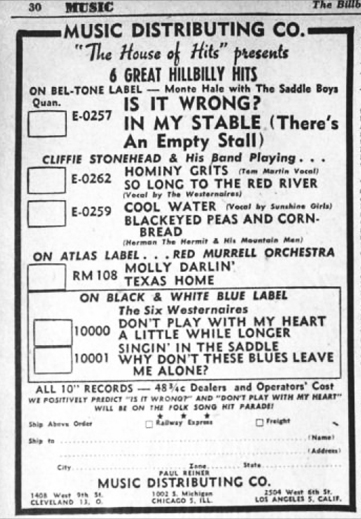
"Tex Travers" (Merle Travis) (g, voc); Cliffie Stone (b, dir); unidentified (cl); unidentified (p); unidentified (acc); unidentified (vln); The Sunshine Girls (unidentified female vocalists on %).
Los Angeles, probably 1944%
International Studios, Los Angeles, c. August 3, 1945
| ERS 101-A (BT-01) | Cool Water (Nolan)% | Lariat 101A, Bel-Tone E0259$, Gold Seal 1701* | |
| BT-17-2 | Hominy Grits (Burnette) | Bel-Tone E-0262^, Gold Seal 1701* |
Lariat 101 was a 78-rpm single released most likely in 1945. There was probably also a Lariat 102 from this same session (with ERS 102-B as one of the matrix numbers); it would be reissued as Bel-Tone E-0260.
A later Lariat company, also operating out of Hollywood, opened in March 1952, but it had a blue label in place of the original red. The owner of the latter-day Lariat was Ken Wilson, who was sporadically active before and after that time as a Country and Western producer on the West Coast. Following Dave Schroeder, we suspect that the first Lariat was owned by Cliffie Stonehead himself, and that he quickly closed it, first to go with Bel-Tone, then with Capitol.
The prominent reference to a contract with the American Federation of Musicians on the Lariat labels suggests that Stonehead's independent signed with the AFM before most of the majors showed an interest in doing so; this is a clue that the session took place in 1944.
Bel-Tone E0259 was a 78-rpm single released before November 1945; it was a straight reissue of Lariat 101 (for a picture of the A side, see http://hillbilly-researcher.blogspot.com/2010/06/lariat-records.html). On the Bel-Tone "Cool Water" was credited to the Sunshine Girls with Cliffie Stonehead and His Band. On the Lariat the band was referred to as Cliffie Stonehead's Harmony Homesteaders. The original coupling on both Lariat and Bel-Tone, but not used by Gold Seal, was ERS 103-A/BT-03, "Black Eyed Peas and Cornbread," by Herman the Hermit and His Mountain Men (composer credit to Rice and Stonehead). Herman the Hermit was, of course, Clifford Snyder Sr.; he would later make a session for Bel-Tone with backing by his son's band (it produced Bel-Tone 272, subsequently reissued as Gold Seal 4849).
The original matrix numbers, seen on Lariat 101 as well as on some pressings of E0259, were ERS 101-A and 103-A, instead of BT01 and BT03. Lariat 102 (probably) and some pressings of Bel-Tone E-0260 (definitely) carried ERS 102-B on one side.
As Dave Schroeder recently brought to our attention (email communication, March 8, 2015), Gold Seal 1701 was further packaged into an album, Gold Seal Presents Cowboy Songs with Cliffie Stone and his orchestra. Gold Seal's second and last known album had four pockets; the front cover advertised the presence of Monte Hale, Eddie Dean, and Herman the Hermit (all had been Bel-Tone artists) along with "Tex Travers." For a listing of 1701 as part of this album, see the Smithsonian website, http://americanhistory.si.edu/collections/search/object/nmah_1214380.
"Hominy Grits" originally appeared on Bel-Tone E-0262, with credits to Tem Martin, another avatar of Merle Travis, with Cliffie Stonehead and His Band. Its original diskmate was "So Long to the Red River," with a vocal by The Westernaires. These were made directly for Bel-Tone. The session was cut at a studio called International, around August 3, 1945. Bel-Tone E-0262 was released in November 1945.
Gold Seal 1701 was released toward the end of 1947.
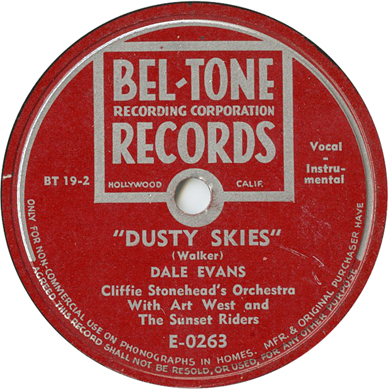
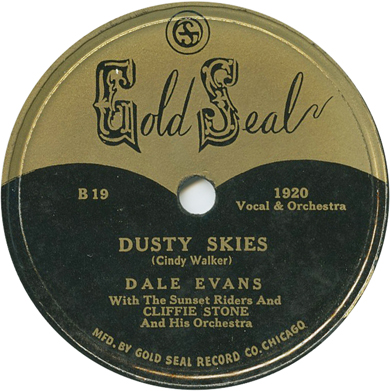
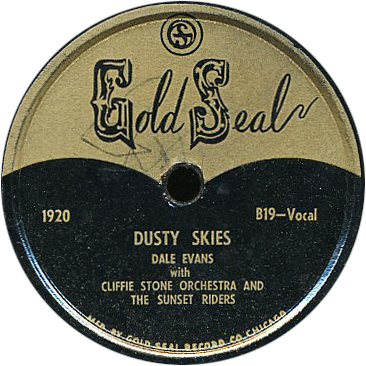
Another hybrid reissue was Gold Seal 1920 by Dale Evans, also with a Cliffie Stone band and chorus. Born Lucille Wood Smith (name quickly changed to Frances Octavia Smith) in Uvalde, Texas on October 31, 1912, she eloped at 14 and had a son at 15. Dale Evans adopted her stage name in 1935, at the insistence of a radio station manager in Louisville, Kentucky. Though she had been singing professionally and doing radio work since she was 16, she was fairly new to commercial recording when Bel-Tone approached her. She had made her debut in 1940, singing on an Abe Lyman record for Bluebird, then in 1942 begun appearing on Armed Forces Radio Services broadcasts, where she was a regular for several years. She started appearing in movies in 1943 and made her first picture with Roy Rogers in 1944.
Dale Evans' Bel-Tone session was the very first commercial outing under her own name. The original releases on Bel-Tone E-0263 and Bel-Tone E-0264 coupled two Western songs on the first record and two sentimental songs on the second.
A reissue, as the company was on its way out, on Bel-Tone 277 took advantage of the bandleader's name change (to Cliffie Stone) and recoupled "If You Ever Come to Texas" with "Will You Be My Darlin'?" (Our thanks to Emil Pinta for information on Bel-Tone 277, which has previously been described, inaccurately, as a straight-up reissue of E-0263.) Gold Seal also wisely traded in the droopier number from E-0264, "Welcome to My Heart" (with a writing credit to Dale Evans' third husband, Dale Butts), for "Dusty Skies" from E-0263. "Dusty" evokes the Roy Rogers movies; it includes a plethora of simulated hoof-clops.
There is a thorough description of Dale Evans' early recording career in Raymond E. White, King of the Cowboys, Queen of the West: Roy Rogers and Dale Evans (Madison: University of Wisconsin Press, 2005, pp. 54-55), though, following previous Country discographers, White incorrectly dates her Bel-Tone session to 1944.
Dale Evans' later years (she married Roy Rogers in 1947, appeared in movies and in two TV series with him, and wrote their theme song, "Happy Trails") are well documented in many sources. She died in Apple Valley, Califonrnia, on February 7, 2001.
Dale Evans (voc); Cliffie Stone (b, dir); unidentified (acl); unidentified (fl, ocarina); unidentified (vln); unidentified (p); The Sunset Riders (unidentified mixed chorus).
Los Angeles, c. August 1945
| BT-18-4 | If You Ever Come to Texas (Jack Elliott) | Bel-Tone E-0263, Bel-Tone 277 | |
| BT-19-2 B19 |
Dusty Skies (Cindy Walker) | Bel-Tone E-0263, Gold Seal 1920 | |
| BT-20-2 B20 |
Will You Be My Darlin'? (Jack Owens-Mary Ann Owens) | Bel-Tone E-0264, Bel-Tone 277, Gold Seal 1920 | |
| BT-21-1 | Welcome to My Heart (Jack Elliott-Dale Butts) | Bel-Tone E-0264 |
The Dale Evans session appears in the Bel-Tone matrix series right after the Cliffie Stone-led outing that produced "Hominy Grits." So a date in August 1945 is most likely. An uncredited male vocalist engages in some dialogue with Dale Evans on "Will You Be My Darlin'?" We don't know whether this is Cliffie Stone, or a member of the Sunset Riders. Unsually, the studio band features an alto clarinet, whose chalumeau-register undulations nicely complement the hoof-clops. Bel-Tone E-0263 and 0264 were reviewed together in Billboard on February 16, 1946 (p. 96).
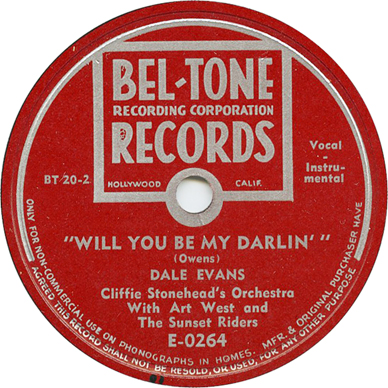
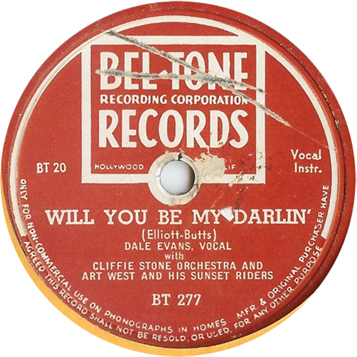
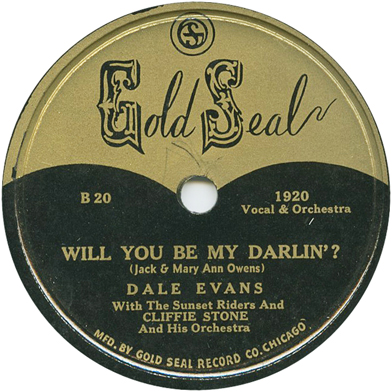
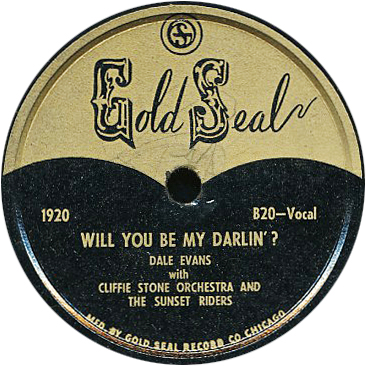
The Dale Evans Gold Seal had to have gotten a little traction commercially. It was pressed at least twice, because the label was printed in two distinct versions, one of which leaves off the composer credits. The artist identifications differ slightly on the two versions.
Eddie Dean was mentioned in the Billboard announcement, and Bel-Tone had put some money behind his releases (there were four, made at two recording sessions: E-0267, E-0268, 269, and 273). Born Edgar Dean Glosup in Posey, Texas, on July 9, 1907, he was touring in gospel groups at age 16. He and his brother Jimmie then did radio work in Yankton, South Dakota, and for WLS in Chicago. His first film appearance was in 1934; in 1937, he moved to Hollywood, where he got his first starring role in 1944, working for a low-budget studio called Pioneer Releasing Corporation, which put out 1-hour Westerns in color. His films were commercially successful, and he made a string of them through 1948 (those done in 1947 and 1948 reverted to black and white). His subsequent acting was limited to a few appearances on TV shows. Meanwhile, Dean had begun recording under his own name in 1941, for Standard, ARC, Just Film, Decca, and Radio Recorders. So Bel-Tone was his sixth label.
Like Dale Evans, Dean would leave Bel-Tone for Majestic. Billboard announced on August 24, 1946 (p. 116) that Dean not only had a new cowboy movie to promote; he had signed with the New York-based company and had two brand-new singles out on it.
Gold Seal obviously expected sales out of Dean. The company reissued six of his eight Bel-Tone sides: two from his first session, and all four from his second. We are showing the complete first session FYI.
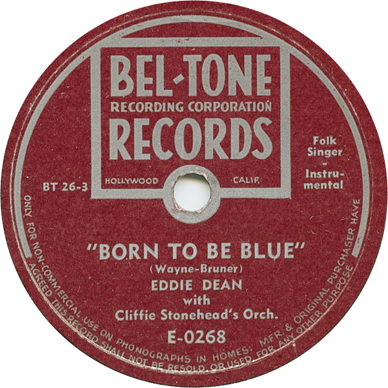
Eddie Dean (voc); Cliffie Stone (b, dir); others unidentified.
Los Angeles, c. September 1945
| BT-26-3 | Born to Be Blue (Wayne-Bruner) | Bel-Tone E-0268 | |
| BT-27-2 | Careless Darlin' (Ernest Tubbs [sic]) | Bel-Tone E-0267 | |
| BT-28-3 B28 |
This Lonely World (Dean-Canova) | Bel-Tone E-0267, Gold Seal 2829 | |
| BT-29-1 B29 |
The Low Road's Good Enough for Me (Dean-Canova) | Bel-Tone E-0268, Gold Seal 2829 |

Gold Seal was also sufficiently interested in Merle Travis to motivate putting out a second "Tex Travers" record. This one poses a mildly interesting problem, since on the original Bel-Tone release the vocals were credited to Cliffie Stone.

"Tex Travers" (Merle Travis) (g, voc—but see below); Cliffie Stonehead (b, dir); others unidentified.
Los Angeles, January or February 1946
| BT 46-3 B46 |
I'm Sick and Tired of You Little Darling (Stone-Travis) | Bel-Tone 271, Gold Seal 4647* | |
| BT 47-2 B47 |
I'll Never Do It Again (Stone-Tuttle-Rice) | Bel-Tone 271, Gold Seal 4647* |
We learned about this Gold Seal release from Dave Schroeder (email communication, March 8, 2015). The Bel-Tone original is quite rare, but courtesy of the 45worlds.com site we've at last been able to see photos of the labels. The matrix numbers tell us it was made at the same session as Bel-Tone 272 (BT-48 and 49, by Herman the Hermit with Cliffie Stonehead and His Western Stars). The session must have taken place shortly after BT 42 through 45 by Slim Gaillard (which has been dated January 1946).
One reason Gold Seal might have wanted "I'm Sick and Tired": It was one of several that Travis had rerecord it for Capitol and his records for the bigger company were bringing in some revenue.
Gold Seal even picked up the Herman the Hermit sides from the same session. On this artist (real name Clifford Herman Snyder; he was the father of Clifford Gilpin Snyder), see above.
Clifford Herman Snyder (aka Herman the Hermit) (bj, voc); Clifford Gilpin Snyder (aka Cliffie Stonehead) (b, dir); other musicians unidentified.
Los Angeles, January or February 1946
| BT 48-1 B48 |
I Met Her in the Garden | Bel-Tone 272, Gold Seal 4849* | |
| BT 49-1 B49 |
Beautiful Brown Eyes | Bel-Tone 272, Gold Seal 4849* |
These two sides are the only ones that Herman the Hermit cut on this session, which he shared with his son, Cliffie Stone, and Merle Travis (see directly above). Matrix numbers BT 50 through 53 remain blank in our Bel-Tone discography; we have no way to know who, if anyone, was responsible for them.
For Herman's appearance on Gold Seal 4849, see http://americanhistory.si.edu/collections/search/object/nmah_1214381. The 78 was included in Gold Seal's second and last album, Cowboy Songs with Cliffie Stone and his orchestra.
Healy referred to another country single on Gold Seal—by Cotton Thompson ("How Long" b/w "Hopeless Love" on Gold Seal 1381—but he did not specify matrix numbers or identify any Bel-Tone original. Thompson had been the fiddle player in Bob Wills' Western Swing combo; he went to Hollywood with Wills in 1944 to "do cowboy movies."
It turns out (as per an email communication from Dave Schroeder, March 8, 2015) that there was a Cotton Thompson single with those titles—but it appeared on Gold Star 1381, with strictly A and B matrix numbers. The full label credit is to Cotton Thompson with Deacon (Rag-Mop) Anderson and the Village Boys, and both sides are firmly in the Western Swing idiom. Thompson's single was obviously made on a return trip to Texas, as Bill Quinn's company was located in Houston, and later than 1945, as Quinn hadn't opened his business yet. A YouTube video includes dubs of both sides (and a picture of Side A): https://www.youtube.com/watch?v=qj-Xe8X4XdA .
Gold Seal must have liked Eddie Dean's second Bel-Tone session better than the first. After his releases on E-0267, E-0268, and 269, there had been a pause before the last one. There's a good chance Bel-Tone 273 came out after Dean had left the company. In 1949, Majestic collapsed and Dean moved on to Mercury as that company was acquiring many of Majestic's remains.
Eddie Dean (voc); Cliffie Stone(head) (b, dir); other musicians unidentified.
Los Angeles, early 1946
| BT-62-2 | 1501 Miles of Heaven | Bel-Tone 273, Gold Seal 6264* | |
| BT-63-3 | Dream Rose | Bel-Tone 273, Gold Seal 6365* | |
| BT-64 | Cry, Cry, Cry | Bel-Tone 269^, Gold Seal 6264* | |
| BT-65 | For Better or for Worse (For Better or Worse*) | Bel-Tone 269^, Gold Seal 6365* |
Gold Seal did not retain the original Bel-Tone pairings, but it did use all four sides from this session. Gold Seal 6264 has shown up on eBay and can be seen at 45worlds.com; Gold Seal 6365 is in the National Museum of American History, as part of the 4-pocket Gold Seal album, Presents Cowboy Songs with Cliffie Stone and his Orchestra: http://americanhistory.si.edu/collections/search/object/nmah_1214382.
Dates for most Bel-Tone sessions are unclear. We have a pretty good idea about this one, however; it took place a little while after Slim Gaillard's BT42 through 45 (January 1946).
Dean wrote a big Country hit, "One Has My Name (The Other Has My Heart)" in 1948, and recorded another, "Hill-Billy Heaven," with Hal Southern in 1955. After his years with Mercury, Dean continued to record for smaller labels, continuing into the 1990s. He also kept writing songs, and was one of the founders of the Academy of Country Music. Eddie Dean died in Westlake Village, California, at the age of 91, on March 4, 1999.
Gold Seal also wanted items by other Bel-Tone artists, such as Monte Hale and The Saddle Lads. Though he never attained the fame of Roy Rogers or Gene Autry, Hale was another singing cowboy busily turning out movies in the 1940s. Born Samuel Buren Ely in Ada, Oklahoma, on June 8, 1919, he played guitar and sang at rodeos and in other engagements. During World War II, a job with the Stars over Texas Bond Drive introduced him to several people who worked for Republic Pictures. He signed a 7-year contract with the company in 1944, changed his name to Monte Hale, and started claiming he had been born in Texas. His first lead role was in Home on the Range, released in 1946. Hale recorded twice for Bel-Tone; his second session, with Cliffie Stone and His Western Stars, included BT66 through 69, and might even have been shared with Eddie Dean (see the previous entry). Gold Seal released one single from his second session.
Monte Hale (voc); Cliffie Stonehead (b, dir); unidentified (p, eg, steel-g, vln).
Los Angeles, early 1946
| BT 66-1 | After All We Have Meant to Each Other (Wayne) | Bel-Tone 274 | |
| BT 67-3 | You Broke My Heart, Little Darlin' (Spencer) | Bel-Tone 274 | |
| BT 68-2 B68 |
I Learned to Love You Too Late, Little Darlin' (Clark-Kenny) | Bel-Tone 270^, Gold Seal 6869* | |
| BT 69-2 B69 |
Honey I Was Right (Stone-Dawson) | Bel-Tone 270^, Gold Seal 6869* |
As noted, this session, Hale's second for Bel-Tone, might have been shared with Eddie Dean, or it might have taken place a few days later. We learned of Gold Seal 6869 from its inclusion in the album, Cowboy Songs with Cliffie Stone and his orchestra, a 4-pocket edition that is preserved in the National Museum of American History, http://americanhistory.si.edu/collections/search/object/nmah_1214383. Photos of the labels are available on the 45worlds site.
Hale got his last starring role in 1950, shortly before his contract with Republic expired. Later in the 1950s, he was cast in a minor role in Giant. On into the 1960s, he made occasional guest appearances on Western-themed TV shows, but mostly concentrated on music. He finally got a star on the Hollywood Walk of Fame in 2004 and died in Studio City, California, on March 29, 2009.
Though we have not seen anything yet, we would not be astonished to find something on Gold Seal by Tin Ear Tanner and his Back Room Boys, another pseudonym employed by Cliffie Stone. According to Bob Healy, the Tin Ear Tanner release on Bel-Tone 275 (BT-82, "I Used to Work in Chicago" b/w BT-81-2, "Cincinnati Lou") included Merle Travis, guitar; Tex Atchison, fiddle; Smoky Rogers, accordion; and Cliffie Stone, bass. Its companion, on Bel-Tone 276, shows matrix numbers BT-80 and BT-83 and features guitar, accordion, and bass, plus some piano but no fiddle. The publisher of "Kilroy Was Here" not only advertised the release on Bel-Tone 276 (Billboard, August 31, 1946, p. 20), but even listed the personnel: Merle Travis, Art Wenzel, Tex Atchisson [sic], and Tin Ear himself (Cliffie Stone). The Tanner sides were recorded around September 20, 1945. Their late placement in the Bel-Tone matrix series (along with the employment of a pseudonym for artists who were actually affilated with the label) indicate that they were originally recorded for still another small outfit in Southern California, then shopped to Bel-Tone. In fact, one of the four sides carried the matrix number UH-8636. Bel-Tone 276 was mentioned in Billboard on April 20, 1946 (p. 27) and garnered a review on May 4, 1946.
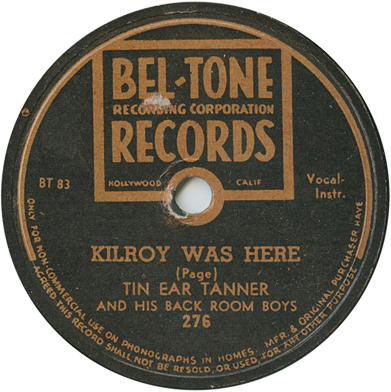
Finally, Gold Seal took advantage of the growing popularity of the eclectic pop singer Frankie Laine, whose first two sides had appeared on the first two Bel-Tone releases, S-0255 and S-0256. The story behind these was so convoluted, the original Bel-Tones so scarce, and the Gold Seal practice of recoupling Bel-Tone sides so confusing, that even the meticulous compilers of a Bear Family set of Laine's earliest recordings got it partly wrong.
First, some background on Laine. The singer was born Francesco LoVecchio, in Chicago on March 30, 1913; he was the oldest of 8 children. His mother, who worked in a grocery store, and father, a barber, were both Sicilian immigrants. In high school, he became an admirer of Bessie Smith and Al Jolson, then of Louis Armstrong and other jazz performers; when he was 15, he made his debut as a singer at a friend's birthday party. LoVecchio's professional career began as the Depression was beginning to bite; for over a decade, he moved back and forth from Chicago to Cleveland and New York City, often having to take day jobs and working the dance marathon circuit as well as the clubs. During a stint at WINS in New York, he took the name Frankie Laine at the suggestion of the station manager. In 1943, he moved to Los Angeles, where his then-girlfriend's group had signed with Capitol; he worked in a factory making airplane parts and began to pick up a few gigs. In 1944, he met jazz pianist Wini Beatty and began taking gigs with her group. When Dick Elwell decided to record him for Bel-Tone, Laine was already 32 years old.
Laine was not the featured attraction on this session, just part of a working quartet. At the Bel-Tone session, he sang on two sides, Wini Beatty sang on one, and guitarist Gene Sargent got the fourth.
Years later, Laine would recall the date as 1944, but Bel-Tone wasn't officially launched till July 1945; S-0255 and S-0256 were the first two items in its initial release series, though they may not have been the first to hit the shelves. It's worth noting that their matrix numbers were in a different series from other Bel-Tones. The band's lineup also changed over time. In 1944, Arv Garrison was the group's guitarist and Vivien Garry was on bass. For a while during 1945, Bulee "Slim" Gaillard was the guitarist before Sargent replaced him. And Laine got the call from another Southern California independent shortly after his sole outing for Bel-Tone. His first recording for Atlas, on which he sang one title with Oscar Moore's Three Blazers, was advertised in Billboard on July 14, 1945; he would remain with Atlas until some time in the first half of 1946.
So the meticulously researched book to Bear Family's first Frankie Laine set gives the wrong recording date and the wrong lineup for the group. The Bear Family researchers had access to the second version of Bel-Tone S-0255, and to the Gold Seal release, but not to Bel-Tone S-0256, which identified Gene Sargent as one of the participants. Bel-Tone S-0255 does seem to be more common...
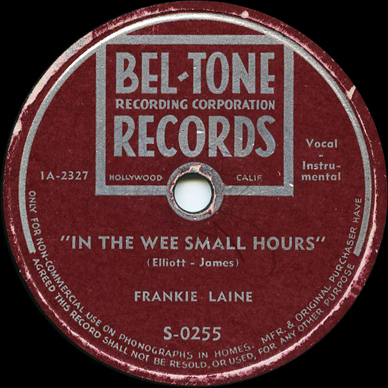
We are listing the entire session for completeness. Matrix IA-2325 was a novelty number released under Gene Sargent's name; IA-2326 was released under Wini Beatty's. The artist identifications are as on Gold Seal 7262, which carries the numbers IA-2324 and IA-2327 in the trailoff area; in fact, the Gold Seal looks as though it might have been pressed with Bel-Tone stampers. Composer credits (which were left off the Gold Seal) are taken from the first release of Bel-Tone S-0255. Like the Bear Family researchers, we have seen S-0255 (first version, in our case) but not S-0256.
Frankie Lane (voc); Wini Beatty (p, voc); Gene Sargent (eg, voc); prob. Mildred V. Christy (aka Vivien Garry) (b); The Hollywoodsmen (vocal group on *).
Hollywood, c. June 1945
| IA-2324 | That's Liberty [FL voc]* | Bel-Tone S-0256, Bel-Tone S-0255, Gold Seal 7262*, Bear Family BCD 16361 | |
| IA-2325 | Six Rears Its Ugly Head [GS voc] | Bel-Tone S-0256 | |
| IA-2326 | You're a Character, Dear (Elliott-Fascinato) [WB voc] | Bel-Tone S-0256 [sic, should be S-0255] | |
| IA-2327 | In the Wee Small Hours (Elliott-James) [FL voc] | Bel-Tone S-0255, Gold Seal 7262*, Bear Family BCD 16361 |
Bel-Tone S-0255 and S-0256 were advertised in Billboard on September 1, 1945; they may, of course, have been released earlier. The original pairing on S-0255 was "In the Wee Small Hours" and "You're a Character, Dear," while S-0256 was "That's Liberty" and "Six Rears Its Ugly Head." Once it became clear whose vocals were selling and whose weren't, "In the Wee Small Hours" and "That's Liberty" were re-paired as S-0255, the same coupling that Gold Seal would later use. The IA's appear in the trail-off shellac to the Bel-Tones as 1A's.
If this session was made before Laine signed with Atlas, it would have to have been from June 1945 or earlier. Another clue is that the matrix numbers are not from Bel-Tone's regular series, which started with BT-01. The session thus appears to pre-date the label's Country outings, which started in late July 1945. The IA prefix may indicate the studio at which they were cut. The matrix numbers could not be easily combined into a 4-digit Gold Seal release number, so 7262 was picked instead.
Bear Family BCD 16361 is a 6-CD boxed set from 2000, made in Germany and titled Frankie Lane: That Lucky Old Sun. We have drawn most of our Laine biography from the illustrated book by Todd Everett that was included in the set. The book's discography lists Bel-Tone S-0255, but not S-0256, and Gold Seal 7262. The personnel given for the group probably came from an interview with Wini Beatty; it puts Arv Garrison on guitar and Vivien Garry on bass. But the Bel-Tone session was made with a later edition of the group that included Gene Sargent on guitar.
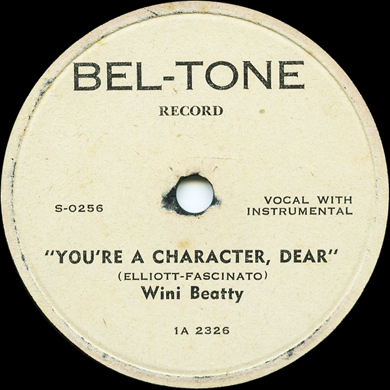
Frankie Laine continued to work with Wini Beatty's group for a little while after the Bel-Tones came out. On September 10, 1945, a quartet of Laine, Beatty, Sargent, and a bassist started a four-week engagement. Later, the group added a drummer. An underaged tenor saxophonist named Stan Getz sometimes sat in with the larger group; a photograph of him with them is extant. Although Laine didn't stay with Bel-Tone, Wini Beatty did; she recorded a session with Slim Gaillard that was released in the 750 series.
Toward the end of 1945, the group broke up and Laine began sitting in at Billy Berg's club. Early in 1946, he began working with pianist and arranger Carl Fischer; in March, he was picked up for a recording session with Mercury, and in August 1946 Laine was signed by the much bigger company.
At Mercury, Frankie Laine proved to be a major hit-maker. In 1951, he followed his producer Mitch Miller over to Columbia, where he recorded prolifically for over a decade. In 1963 Laine signed with Capitol, and in 1965 he went to ABC, recording for smaller labels thereafter. He made his last studio recording in 2001, at the age of 88, and his last public performance in 2006, at 92. Frankie Laine died in San Diego, California, on February 6, 2007.
Also originating from Bel-Tone was a sort of rhythm and blues release by Valaida Snow with Buzz Adlam's Orchestra, recorded in December 1945 (our thanks to Richard Reicheg for first alerting us to this one). Born in Chattanooga, Tennessee, on June 2, 1904, Valaida Snow was part of a show-biz family; besides singing and dancing, she learned to play 10 instruments, eventually settling on the trumpet. In the late 1920s, she toured the Far East with Jack Carter's Serenaders. She spent most of the 1930s in Europe, where she made her first records, and was still in Denmark when it was conquered by the Nazis. After being imprisoned there, she was allowed to return home in 1942. In 1945-1946, she worked extended engagements in Los Angeles, which led her to Bel-Tone.
Snow's Bel-Tones, made at two sessions, were in the 7000 series. If he had not seen her perform earlier, Leonard Klein surely noticed when Valaida was headlining in Chicago, at the Rhumboogie Café:, from Christmas 1946 through late January 1947.
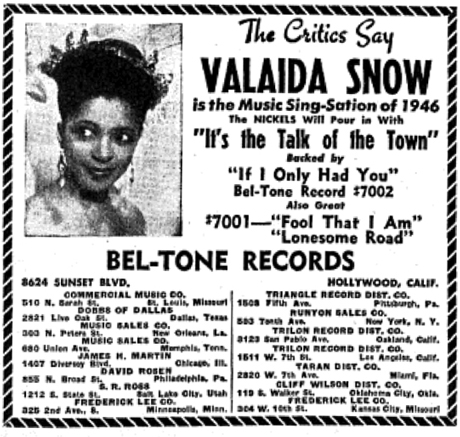
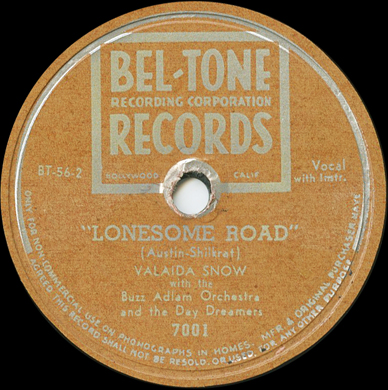
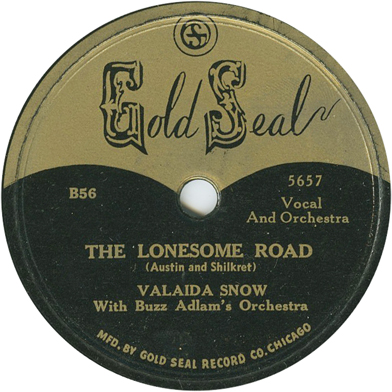
Valaida Snow (voc); Buzz Adlam (dir); unidentifed (tps); unidentified (tbs); unidentified (saxes); unidentified (fl); unidentified (p); unidentified (harp); unidentified (g); unidentified (b); unidentified (d); The Day Dreamers (unidentified mixed chorus).
Los Angeles, c. January 1946
| BT-54-1 | Fool That I Am (Hunt) | Bel-Tone 7001, Classics [Fr] 1343 [CD] | |
| BT-55-4 | It's the Talk of the Town (Symes-Neiburg-Levinson) | Bel-Tone 7002, Classics [Fr] 1343 [CD] | |
| BT-56-2 B56 |
Lonesome Road (Austin-Shilkret) | Bel-Tone 7001, Gold Seal 5657, Classics [Fr] 1343 [CD] | |
| BT-57-3 B57 |
If I Only Had You (Surrell-Edwards) | Bel-Tone 7002, Gold Seal 5657, Classics [Fr] 1343 [CD] |
"The Lonesome Road" (BT-56-2) was coupled with "If I Only Had You" (BT-57-3), so Gold Seal, with impeccable logic, gave the record the number 5657. Gold Seal 5657 took "Lonesome Road" off Bel-Tone 7001 and "If I Only Had You" from Bel-Tone 7002. Tom Lord's Jazz Discography gives December 1945 as the recording date, but this session appears to have taken place after the celebrated Slim Gaillard outing with special guests, which can be reliably dated to December 29, 1945. For some reason, Bel-Tone 7002 credits "If I Only Had You" to Surrell only.
All four sides from this session were reissued on CD in France in 2004. Classics 1343 was titled Valaida Snow 1940-1953.

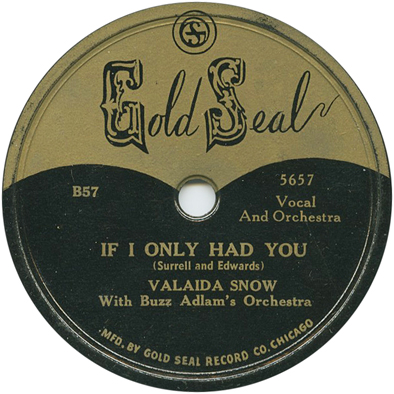
Valaida doesn't play her trumpet here, and Adlam presides over a Hollywood big band plus a complement of strings, a flute, and a harp. There is also a mixed chorus, The Day Dreamers, credited by name on Bel-Tone 7001 and 7002, but not on Gold Seal. However, strings and chorus are employed with a fair amount of discretion and do not overwhelm the singer.
Bel-Tone recorded Valaida again (her second session, toward the end of the label's run, took place in the spring of 1946, using matrix numbers BT-98 through BT-101). The sides from her second session were released in June 1946, on Bel-Tone 7007 and 7008, which were the last in the 7000 series to use the old label design; they, too, were reissued in 2004 on Classics 1343.
The second session was again trumpetless and given over to Hollywood production, employing a studio orchestra led by Ramon or Raymond Joel Sanns (his first name was spelled "Raymon" on the labels). There were lots and lots of strings, an oboe, and a bassoon, in addition to the standard big band instrumentation. One W. Sheets was credited with orchestrating two of the sides. On the positive side, Bel-Tone ditched the chorus and programmed such numbers as "Caravan" (with lyrics) and "I Must Have That Man." The two singles received a favorable review in Billboard on June 29, 1946 (p. 122). Sanns, the leader of a 22 piece orchestra, was subsequently tapped to make some of Bel-Tone's "kidisks." On one of these, Bel-Tone album BT-4, Sanns was said, in a bit of revisionist history, to have been Bel-Tone's music director since the label opened for business!
For Valaida Snow's career post-Bel-Tone, see our Chess page (her last record was Chess 1555, made while she was headlinging at the Crown Propeller Lounge in Chicago). Valaida Snow died of a stroke on May 30, 1956, at the Palace Theater in New York City; she was 51 years old.
Although some of the masters Gold Seal got from Bel-Tone had actually been cut for other small labels, such as Lariat, the company also made a direct deal with a different California-based independent called Acme. What Gold Seal was after in this case was masters by Red Murrell and His Ozark Playboys.
Joyce Wayne "Red" Murrell was born in Willow Springs, Missouri, on June 27, 1921. An accomplished guitarist in the Western Swing style, he did a lot of session work in California in the 1940s; meanwhile, his Ozark Playboys were one of the top Western Swing bands on the West Coast. They also recorded for the Atlas label in Southern California. In 1954, Murrell became a disc jockey for KEEN in San Jose. In later years, he went into advertising and public relations. Red Murrell died in Lodi, California, on February 10, 2001, at the age of 79 (see http://www.recordnet.com/apps/pbcs.dll/article?AID=/20010214/A_NEWS21/302149998).
The Hillbilly Researcher site (http://hillbilly-researcher.blogspot.com/2010/07/acme-1.html) mentioned Acme 1001 and 1002, reissued by Gold Seal as A230 and A540. Label photos of these two items can be seen on the Gold Seal label discography at 45worlds: http://www.45worlds.com/78rpm/label/gold-seal,
The Gold Seal labels change the group's handle to Red Murrell and His Ozark Mountain Boys; they also show an A prefix instead of Acme's AC for the matrix numbers.These weren't all. A Gold Seal reissue of Acme 1003 has recently turned up (our thanks to Han Enderman for this information). Murrell had also had a single on Acme 1000. We hadn't previously encountered a Gold Seal edition, until one turned up for sale in 2021 as Gold Seal A010. It also apparently reversed the matrix numbers for the two sides (Gold Seal changed the AC prefix into an A).
One side of Acme 1003 and the third Gold Seal is "Hound Dog Blues," with matrix number AC-67. The other side of the Acme was "Forever Faithful" with matrix AC-66, but this doesn't guarantee anything about the Gold Seal—not when the company so liked to mix and match the sides it got from Bel-Tone. The Gold Seal issue number is illegible on the photo we have seen—could it have been A670? Murrell, a singer and guitarist who appeared on at least one Cliffie Stone-led session for Bel-Tone, also recorded as a leader during this period for another Southern California indie, Atlas.
We don't have a firm recording date for the Red Murrell Acmes. They could actually be oldest items that Gold Seal picked up for reissue. Until we know more, we are placing them at the end of our Gold Seal listing.
Red Murrell (g, voc); others unidentified.
Los Angeles, 1944 or 1945?
| AC60 A61 |
I've Got a New Baby (Hensley-Murrell) | Acme 1000, Gold Seal A010 | |
| AC61 A60 |
Devil in Disguise (Hensley-Murrell) | Acme 1000, Gold Seal A010 | |
| AC62 A62 |
Naggin' Wife | Acme 1001, Gold Seal A230 | |
| AC63 A63 |
Count Those Broken Hearts | Acme 1001, Gold Seal A230 | |
| AC64 A64 |
There'll Be Someone to Take Your Place (Murrell-Hensley) | Acme 1002, Gold Seal A540 | |
| AC65 A65 |
Better Change Your Tune (Murrell-Hensley) | Acme 1002, Gold Seal A540 | |
| AC66 | Forever Faithful (Murrell-Hensley) | Acme 1003, Gold Seal [to be verified] | |
| AC67 A67 |
Hound Dog Blues (Murrell-Hensley) | Acme 1003, Gold Seal [number illegible] |
Our basic information on the Red Murrell Acme releases comes from the Hillbilly-Researcher post on the label (http://hillbilly-researcher.blogspot.com/2010/07/acme-1.html), with the addition of a label shot of Acme 1003 provided by Han Enderman. Two of the Gold Seal reissues are documented on the 45worlds site (http://www.45worlds.com/78rpm/label/gold-seal). We have confirmation that there were also four Gold Seal releases (though it would be nice to have better information than a photo of the "Hound Dog Blues" side with a sticker partly covering the release number.
When last heard from, Gold Seal was still pursuing expansion. Maybe just talking about pursuing expansion. The Billboard item from November 8, 1947 had suggested that Klein might arrange for sides to be cut in Argentina or Switzerland, where he claimed he had distribution, if the second Petrillo ban went on too long. We know of no such recordings. A story filed on February 14, 1948 ("Gold Seal-Musicana Yank-Canuck Deal") announced that Gold Seal had just added distributors in St. Louis, Philadelphia, Jackson, Mississippi, New Orleans, Dallas, Houston, El Paso, Los Angeles and San Francisco. The headline signaled that a licensing deal had been struck with Musicana Ltd. to press Gold Seal records in Canada. "The diskery's prexy, Leonard Klein, is also trying to arrange a similar European set-up, at the same time seeking to acquire a European classical catalog for distribution here" (Billboard, February 21, 1948, p. 36).
We suspect that the late activity, after the second Petrillo ban hit on January 1, 1948, was entirely focused on Country reissues from Bel-Tone and Acme; nothing ever materialized of European Classical provenance. The last mention of Leonard Klein and Gold Seal comes from Cash Box (October 30, 1948, p. 9); he had recently been in Los Angeles (the former home of Bel-Tone) trying to sell some of his records. The Chicago Gold Seal label had not previously drawn any attention from Cash Box, but by this time Klein, who desperately wanted people to know he still had a label, probably wasn't getting his calls returned at Billboard
Gold Seal had never scored a hit and was fatally overextended. Its near-contemporary, Vitacoustic, made a very public spiral into bankruptcy and then liquidation. But Vitacoustic had spent as though it was going to become a major label and it owed huge sums to both Universal Recording and United Broadcasting, as well as to some of its artists. Bel-Tone, whose sides Gold Seal had reissued, had gotten press coverage when it filed for its own bankruptcy, owing $40,000. The sums that Gold Seal owed were much more modest (it had never splurged on studio time, and we're guessing it was paid up on its bills in that department), and the players to whom they were owed much less important. And it had never bought a single advertisement in the trades. So no publicity attended the company's downfall. By the end of 1948 Gold Seal had passed into history.
After committing some years of research, we still have to say that Gold Seal's total output is not fully known. The 100 series consisted of 101, 102, and 103, all part of an album by Robert Crum. The 330 Country series consisted of 330, 331, 333, 336, and 337. The 3000/3500 keyboard series included at least ten items: 3501, 3502, 3003, 3503, 3504, 3505, 3507, 3508, 3509, and 3517. An unknown series included at least one Arthur Lee Simpkins record. These make 19 releases originally recorded for the label.
We presently know of 8 Country and Western releases derived from Bel-Tone: 1701, 1920, 2829, 4647, 4849, 6264, 6365, and 6869 from the Bel-Tone 0250 series. Cliffie Stone(head) material from Bel-Tone was considered promising enough to merit release in an album, Cowboy Songs with Cliffie Stone and his orchestra, that repackaged four of the foregoing. Then there were 4 reissues of Red Murrell from Acme (A010, A230 and A540, plus one with an unknown release number). There was a Frankie Laine release from the beginning of the Bel-Tone 0250 series before it focused on Country, 7262, and a Valaida Snow release derived from Bel-Tone's 7000 series, 5657. These give us 14 reissues and 33 Gold Seals in all, numbers still subject to revision.
Just one Gold Seal was reissued before the CD era: Max Miller took 401 with him (or did Paul Eduard Miller, his sponsor, take it with him?) when he signed with Life Records in 1950, so it reappeared as Life 1003.
A source of confusion is that two other Gold Seal labels were in operation around the same time as the Chicago-based company. The more prominent of these other companies was based in New York City. We don't know just when Leonard Klein went to work for United Broadcasting in Chicago, and we still lack ownership information on the New York outfit, but Chicago and New York Gold Seal products are sufficiently different as to indicate that they came from different operations.
The first release that we know of from the New York operation is a 3-pocket album of Romany Airs by Shandor's Gypsymfonette, a Gypsy café band with Alexandor Shandor Godla, Charles Benci, and Maxie Fransko (solo violins), probably Richard Marta (cimbalom), and other musicians unidentified. The Gypsymfonette was said in the liner note to number 12 pieces, but its exact size is hard to gauge because the strings in the orchestra are recessed on the recording. Anthony Barnett figures that, in addition to the soloists, a piano, and a cimbalom, there may have been 5 violins, 2 violas, 1 cello, and 2 string basses. The leader, Alexandor Sandor Godla, often spelled his name "Shandor" for the benefit of Americans unacquainted with Hungarian orthography. The album is labeled "Volume 1" on the spine of the cover. It was announced in a list put out by the Gramophone Shop in New York City, dated February 1946. Interestingly, the announcement mentions 3 78s, but the album actually has pockets for 4, and the liner note lists two further titles that are not on the three 78s included therein. According to Anthony Barnett, it was probably recorded either at WOR Studio in Manhattan or at the studio on Long Island run by another small company called Pilotone.
It turns out that that the promised fourth disk was in fact released by Gold Seal. As far as we know, it was sold separately, but we will list it here for completeness.
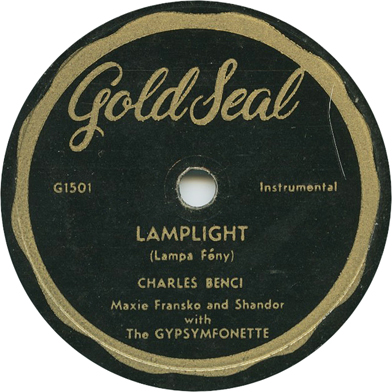
Alexandor Shandor Godla (vln solo, ldr); Charles Benci (vln solo); Maxie Fransko (vln solo) with unidentified (p); prob. Richard Marta (cimbalom); 5 unidentified (vln); 2 unidentified (vla); unidentified (clo); 2 unidentified (b).
New York City, late 1945 or early 1946
| EL-1501 | Lamplight (Lampa Fény) (Benci) -1 | Gold Seal 1501 | |
| EL-1502 | Monti Csardas (Benci) -2 | Gold Seal 1502 | |
| EL-1503 | Kazbek (Louis Kallao) -3 | Gold Seal 1503 | |
| EL-1504 | Gypsy Fantasy (Shandor) -4 | Gold Seal 1504 | |
| EL-1505 | Hora Romana (Shandor) -4 | Gold Seal 1505 | |
| EL-1506 | By the Brook (Shandor) -5 | Gold Seal 1506 | |
| A la Dinicu (Fransko) -6 | Gold Seal 1507 | ||
| Flying Swallow (Repülj Fecském) (Fransko) -7 | Gold Seal 1508 |
There is no number on the album besides the Volume 1 designation. Each side is labeled according to its matrix number; the couplings are, as might be expected, 1501 with 1502, 1503 with 1504, and 1505 with 1506. The EL prefix is incised into the trail-off shellac.
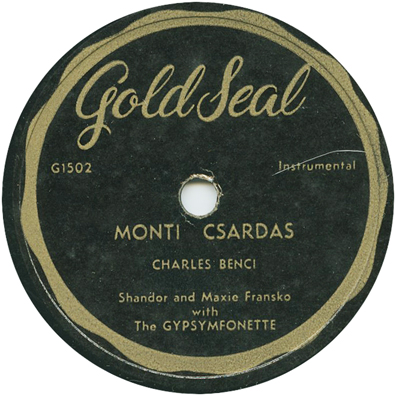
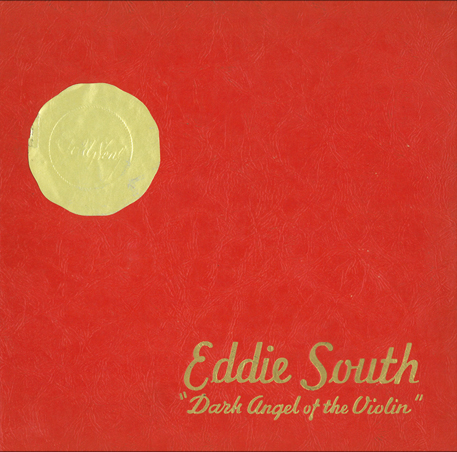
In October or November 1946, the New York Gold Seal put out an album of 4 78s (the album was labeled 200 as well as Volume 3) by violinist Eddie South. On some titles, South played café music with varied lineups drawn from a later edition of Alex Shandor's gypsy orchestra; on others, he appeared as part of a jazz combo. The matrix numbers ran from 2000 through 2007. The complete contents of this album, originally titled Dark Angel of the Violin, were reissued in 2008 on AB Fable Archives ABCD1-021, Eddie South: Dark Angel Album Sets | Columbia-Pilotone-Gold Seal.
The February 1946 release date for the Shandor album seems to rule out involvement by the Chicago-based company. The South album, on the other hand, was released when the Chicago Gold Seal was open for business. Photos of the album's front cover, the liner, and the labels to all 8 sides (all of these are from the collection of Alfred Ticoalu), and further consultation Anthony Barnett (who owns two different versions of the album with different liner notes), indicate that the album cover on the Smith set is highly similar to the cover on the Gypysmfonette set. The manner in which the liner was pasted in is also similiar.
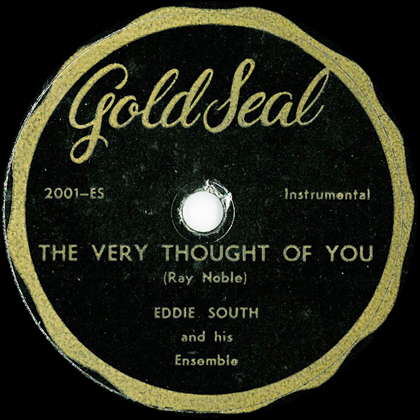
The labels for the Eddie South 78s are also just like the Gypsymfonette labels, in gold script on black with scalloped gold rims. The design is completely different from anything we have seen from the Chicago Gold Seal—the scalloping is quite unusual for any record label of the period—and no company address appears on them. The only other information of interest is a tiny "(c) 1946" on the bottom rim of one of the eight labels in the Eddie South set (no date or copyright symbol appears on any of the Gypsymfonettes).

Eddie South (vln) with Shandor's Gypsy Orchestra: Alexandor Shandor Godla (vln -1); unidentified (vln -1); unidentified (clo -1, 2, 3); Richard Marta (cimbalom -1); unidentified (p); Ted ? (g, eg -2); poss. Leonard Gaskin (b); poss. Jack "the Bear" Parker (d -3).
New York City, late October 1946
| A | Best Years of My Life (Sandor Jenö) -1 | Gold Seal 2005ES | |
| B | Yesterdays (Kern) -1 | Gold Seal 2008ES | |
| C | Twelve O'Clock at Night (Shandor) -1 | Gold Seal 2004ES | |
| D | The Very Thought of You (Noble) -1 | Gold Seal 2001ES | |
| E | Hot Canary (Nero)-2, 3 | Gold Seal 2006ES | |
| F | These Foolish Things (Strachey-Link) -2 | Gold Seal 2002ES | |
| G | Daphne (Reinhardt) -2, 3 | Gold Seal 2003ES | |
| H | Paganini's 24th -2, 3 | Gold Seal 2007ES |
The front of the Eddie South album has an actual gold seal on it, with the words Gold Seal in script, not the gold and black GS monogram that we've seen on the Chicago company's labels. Anthony Barnett has remarked that the South album was a good deal more cheaply produced than the one album that came out of the Chicago-based company, P-10 by Robert Crum. For instance, the Crum album has a photo of the artist on the cover, whereas the Gypsymfonette and South albums show just the gold seal and a title in gold script on a plain red or brown textured cover. The liner to the Gypsymfonette album is a small piece of paper glued to the inside front cover. It lists two tunes that were probably not included in the album. The liner notes to one version of the South album show a handwritten correction of an incorrect song title. The other version has new liners loosely pasted on after the old ones were torn out, leaving a couple of pieces still stuck to the cardboard.
The cover and liners (either version) to the South album have no company address on them. By contrast, everything we have seen from the Chicago-based company prominently notes that it was made in Chicago.
There may, of course, have been further offerings, not yet documented, from the New York Gold Seal. For instance, a Volume 2 album might have been planned at one time.
A Southern California company was also briefly active under the same name. While Bob McGrath's R&B Indies dates the Southern California Gold Seal to 1945, it was mentioned in the trades only during August and September 1946. This was right when the Chicago Gold Seal was starting.
Two singles by trumpet player Red Mack came out on Gold Seal 001 and 002. Lloyd Glenn, who would go on to a high-profile career in R&B, played piano on the date. These were the only releases that would appear on the label.
Red Mack's real name was McClure Morris. He was born in Memphis, Tennessee on January 18, 1912. His family migrated to California when he was a small boy. He started playing the trumpet at school and was working in territory bands as a teenager. In 1930, Red Mack filled in at the Sebastian New Cotton Club when his idol Louis Armstrong was jailed for 9 days for marijuana possession, successfully impersonating Armstrong and playing his trumpet solos on the air. He subsequently played in all of top bands on the West Coast, including those led by Sonny Clay, Lorenzo Flennoy, and Lionel Hampton. In the late 1930s, he began leading his own band. In 1941, he toured with an otherwise all-White band led by Will Osborne, and appeared in the Fred Astaire movie You'll Never Get Rich. In the early 1940s he played in Barney Bigard's All Stars, with Kid Ory on trombone and Charles Mingus on bass.
Mack's few recordings as a leader are part of the Swing to jump to R&B transition. In 1946, Mack also made two singles for Atlas, one of which featured his blues singing. In February 1951, he cut two singles for Mercury which featured his singing on three of the four sides. As Swing went out of fashion, Mack tried to adapt by taking up the organ and the vibes. In 1955, he appeared in The Benny Goodman Story, performing on film with Kid Ory's band. According to Anthony Barnett, Red Mack appeared at a jam session at Stuff Smith's home in Los Angeles (late 50s or early 60s) playing piano and drums and singing. There is also a lo-fi live recording made by a fan at Club Huntington in Los Angeles during July 1969, when Mack sat in on trumpet with the George Mason Quintet featuring Johnny Creach on violin. Mack suffered from health problems that prevented him from playing regularly in public after the early 1960s, but he continued to hold jam sessions in the music room of his house. Red Mack died in Los Angeles on June 14, 1993. We are indebted to Peter Vacher's obituary in The Independent, which ran on July 12, 1993 (http://www.independent.co.uk/news/people/obituary-red-mack-1484442.html), for much of our biographical sketch.

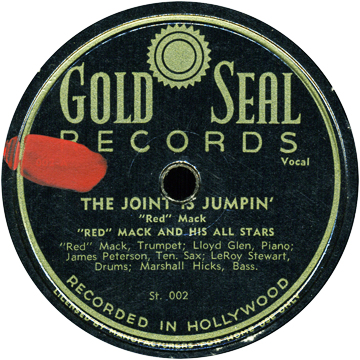
Red Mack (tp, voc); James Peterson (ts); Lloyd Glenn (p); Marshall Hicks (b); LeRoy Stewart (d); ens voc.
Hollywood, July or August 1946
| St. 001 | Gimme Some Skin—Mah Friend (Mack) | Gold Seal 001-B | |
| St. 002 | The Joint Is Jumpin' | Gold Seal 002-A | |
| St. 003 | Hit the Jive, Jack | Gold Seal 001-A | |
| St. 004 | T'aint Me [sic] | Gold Seal 002-B |
Again, the labels on the Red Macks were printed in gold on black. But the design doesn't resemble any we have seen from the Chicago or the New York operations, and "Recorded in Hollywood" is prominently emblazoned on this company's output. The recording date is said to be 1945 in Tom Lord's Jazz Discography, but the only indications we have found of the company's activities are from August and September 1946.
Holiday Distributing Company took out a display ad in Cash Box on August 26, 1946 (p. 19), giving heavy promotion to the two Red Mack releases. An item in Cash Box from September 2 indicated that Holiday "manufactures and distributes Gold Seal and Discos Imperiales records" (p. 59). Holiday was owned by Lew Chudd (the trades called him "Lou" back then) and Max Freitag, and the item (like another to follow on September 9, p. 63) intimated that they were about to start another new record label. Gold Seal 001 and 002 were mentioned again in a Holiday Distributing ad from September 30 that featured its Latin label, Discos Imperiales (Cash Box, p. 21). The kind of display ads we see in Cash Box for Gold Seal 001 and 002 are the kind that Leonard Klein never paid for.
The new record label turned out to be Imperial, whose first releases were mentioned in the September 30 ad. Very quickly Chudd was way too busy with Imperial to try to keep up his Gold Seal line.
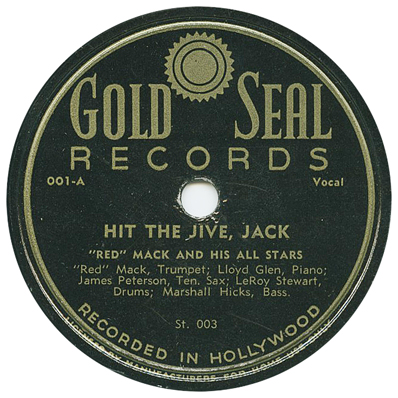

Nobody ever trademarked or copyrighted the phrase "Gold Seal," so others got the same idea from time to time. Back in the 1920s, a company based in St. Paul, Minnesota, Herschel Gold Seal, had been affiliated with Gennett.
Starting in the 1910s, Victor used Red Seal to designate its Classical 78s. When it began making LPs in 1949, RCA Victor called its full-price Classical music line Red Seal. When it subsequently introduced a mid-price line of Classical LPs (for a while there were also 45 rpm EPs), these were called Gold Seal. For a little while in the late 1950s, classical LPs on Columbia's subsidiary Epic were called Gold Seal. Not to be outdone, the American Decca company, a lesser player in the Classical market, issued its own Gold Seal series of LPs in the 1960s.
A company out of Woodside, Queens, New York that specialized in German-language material was known as Lorelei Gold Seal.
There have been still more. In 1955, a company called Singspiration Gold Seal, based in Wheaton, Illinois, released at least one LP by a gospel choir, the Kings Choraliers. It was custom pressed by RCA. A small Seattle-based label, circa 1962, put out a 45 rpm doowop single by Merceedees and the Individuals. A really small San Francisco-based label of the late 1960s was responsible for a 7-inch 33 1/3 rpm single by jazz pianist Earl Hines, satirizing (in songs titled "Ron the Knife" and "The Medi-Cal Blues") the policies of then-Governor Ronald Reagan.
Because the Bel-Tone label has never been properly documented, and we are still learning about releases on it, we are including listings of the company's two known matrix series here. The main BT series ran from 01 to 113; the BTAL series ran from BTAL-01 to a number in the high 20s.
In some cases, we know of a Bel-Tone release but haven't documented the label copy; these will be recognizable from the lack of matrix numbers.
| Matrix | Bel-Tone | Artist | Title | Recording Date | Recording Location | Release Date |
| IA-2324 | S-0255 | Frankie Laine | Brother, That's Liberty | Aug-45 | ||
| IA-2325 | S-0256 | Gene Sargent | Six Rears Its Ugly Head | Aug-45 | ||
| IA-2326 | S-0255 | Wini Beatty | You're a Character, Dear | Aug-45 | ||
| IA-2327 A-1550XX |
S-0255 | Frankie Laine | In the Wee Small Hours | Aug-45 | ||
| ERS 101-A | E0259 | Sunshine Girls with Cliffie Stonehead and His Band | Cool Water | 1944 or 1945 | ||
| ERS102-B | E-0260 | Cliffie Stonehead and His Band | Knock on Wood | 1944 or 1945 | ||
| ERS 103-A | E0259 | Herman the Hermit and His Mountain Men | Black Eyed Peas and Cornbread | 1944 or 1945 | ||
| ERS104-B | E-0260 | Cliffie Stonehead and His Band | Ragtime Doughboy Joe | 1944 or 1945 | ||
| BT 05 | ||||||
| BT 06 | ||||||
| BT 07 | ||||||
| BT 08 | ||||||
| BT 09 | ||||||
| BT 10-5 | E-0258 | Monte Hale with The Saddle Lads | I'm A' Ridin' the Rails | Jul-45 | Aug-45 | |
| BT 11-3 | E-0257 | Monte Hale with The Saddle Lads | Is It Wrong? | Jul-45 | ||
| BT 12-2 | E-0257 | Monte Hale with The Saddle Lads | In My Stable There's an Empty Stall | Jul-45 | ||
| BT 13-6 | E-0258 | Monte Hale with The Saddle Lads | I'm A' Roundin' Up My Love | Jul-45 | Aug-45 | |
| BT 14-3 | E-0262 | The Westernaires with Cliffie Stonehead Band | So Long to the Red River | 3-Aug-45 | International, Hollywood | Nov-45 |
| BT 15-1 | E-0261 | The Westernaires with Cliffie Stonehead Band | When My Blue Moon Turns to Gold Again | 3-Aug-45 | International, Hollywood | |
| BT 16-3 | E-0261 | Scotty Harrell with Cliffie Stonehead Band | Tomorrow Never Comes | 3-Aug-45 | International, Hollywood | |
| BT 17-2 | E-0262 | Tem Martin with Cliffie Stonehead and His Band | Hominy Grits | 3-Aug-45 | International, Hollywood | Nov-45 |
| BT 18-4 | E-0263 | Dale Evans | Cliffie Stonehead's Orchestra with Art West and The Sunset Riders | If You Ever Come to Texas | Aug-45 | Feb-46 | |
| BT 18-4 | 277 | Dale Evans with Cliffie Stone's Orchestra and Art West and his Sunset Riders | If You Ever Come to Texas | Summer or Fall 1946 | ||
| BT 19-2 | E-0263 | Dale Evans | Cliffie Stonehead's Orchestra with Art West and The Sunset Riders | Dusty Skies | Aug-45 | Feb-46 | |
| BT 20-2 | E-0264 | Dale Evans | Cliffie Stonehead's Orchestra with Art West and The Sunset Riders | Won't You Be My Darlin'? | Aug-45 | Feb-46 | |
| BT 20-2 | 277 | Dale Evans with Cliffie Stone's Orchestra and Art West and his Sunset Riders | Won't You Be My Darlin'? | Summer or Fall 1946 | ||
| BT 21-1 | E-0264 | Dale Evans | Cliffie Stonehead's Orchestra with Art West and The Sunset Riders | Welcome to My Heart | Aug-45 | Feb-46 | |
| BT 22-2 | E-0266 | Freddie Stewart | Joe Sanns' Orchestra and The Sweet Swingsters | Diane | |||
| BT 23-2 | E-0266 | Freddie Stewart | Joe Sanns' Orchestra and The Sweet Swingsters | Out of Sight, Out of Mind | |||
| BT 24 | ||||||
| BT 25 | ||||||
| BT 26-3 | E-0268 | Eddie Dean with Cliffie Stonehead's Orch. | Born to Be Blue | |||
| BT 27-2 | E-0267 | Eddie Dean with Cliffie Stonehead's Orch. | Carless Darlin' | |||
| BT 28-3 | E-0267 | Eddie Dean with Cliffie Stonehead's Orch. | This Lonely World | |||
| BT 29-1 | E-0268 | Eddie Dean with Cliffie Stonehead's Orch. | The Low Road's Good Enough for Me | |||
| BTL 30-1 | 2001 | Issy Morales And His Orchestra | Lament | Feb-46 | ||
| BTL 31-2 | 2001 | Issy Morales And His Orchestra | Vocal by Pepin | El Lobo | Feb-46 | ||
| BT 32 | ||||||
| BT 33 | ||||||
| BT 34 | J751 | Bob Mosely & All Stars | Voot Rhythm | |||
| BT 34 | 764 | Bob Mosely & All Stars | Voot Rhythm | |||
| BTJ 35-1 | J752 | Bob Mosely & All Stars | Vocal by M. Abernathy | Stormy Mood | |||
| BTJ 35-1 | 763 | Bob Mosely & All Stars | Stormy Mood | |||
| BT 36-2 | J751 | Bob Mosely & All Stars | Vocal by M. Abernathy | Baggin the Boogie | |||
| BT 36-2 | 763 | Bob Mosely & All Stars | Vocal by M. Abernathy | Baggin the Boogie | |||
| BTJ 37-2 | J752 | Bob Mosely & All Stars | Bee Boogie Boo | |||
| BTJ 37-2 | 764 | Bob Mosely & All Stars | Vocal by M. Abernathy | Bee Boogie Boo | |||
| BT 38-2 | 753 | Slim Gaillard Orchestra | Dizzy Boogie | 29-Dec-45 | ||
| BTJ 39-3 | 758 | Slim Gaillard Orchestra | Flat Foot Floogie | 29-Dec-45 | Jun-46 | |
| BT 40-2 | 753 | Slim Gaillard Orchestra | Popity Pop | 29-Dec-45 | ||
| BT 41-RE | 761 | Slim Gaillard Orchestra | Slim's Jam | 29-Dec-45 | May-46 | |
| BT 42-3 | 754 | Wini Beatty, Piano with Slim Gaillard Trio | Early Morning Boogie | Jan-46 | ||
| BT 43-2 | 754 | Slim Gaillard Trio and Wini Beatty (Vocal and Piano) | That Ain't Right, Baby | Jan-46 | ||
| BT 44-1 | 755 | Slim Gaillard Trio and Wini Beatty, Piano | Riff City | Jan-46 | ||
| BT 45-1 | 755 | Slim Gaillard Trio with Wini Beatty, Piano | Mean Mama Blues | Jan-46 | ||
| BT 46 | 271[?] | Tex Travers with Cliffie Stone | I'm Sick and Tired of You Little Darling | |||
| BT 47 | 271[?] | Tex Travers with Cliffie Stone | I'll Never Do It Again | |||
| BT 48-1 | 272 | Herman the Hermit, Vocal with Cliffie Stone and His Western Stars | I Met Her in the Garden | |||
| BT 49-1 | 272 | Herman the Hermit, Vocal with Cliffie Stone and His Western Stars | Beautiful Brown Eyes | |||
| BT 50 | ||||||
| BT 51 | ||||||
| BT 52 | ||||||
| BT 53 | ||||||
| BT 54-1 | 7001 | Valaida Snow with the Buzz Adlam Orchestra and the Day Dreamers | Fool That I Am | |||
| BT 55-4 | 7002 | Valaida Snow with the Buzz Adlam Orchestra and the Day Dreamers | It's the Talk of the Town | |||
| BT 56-2 | 7001 | Valaida Snow with the Buzz Adlam Orchestra and the Day Dreamers | Lonesome Road | |||
| BT 57-3 | 7002 | Valaida Snow with the Buzz Adlam Orchestra and the Day Dreamers | If I Only Had You | |||
| BT 58-3 | 762 | Slim Gaillard Orchestra | Chicken Rhythm | May-46 | ||
| BT 59-1 | 761 | Slim Gaillard Orchestra | Santa Monica Jump | May-46 | ||
| BT 60-1 | 762 | Slim Gaillard Orchestra | Mean Pretty Mama | May-46 | ||
| BT 61-2 | 758 | Slim Gaiilard Orchestra | Scat Vocals by Gaillard and Brown | School Kids Hop | Jun-46 | ||
| BT 62-2 | 273 | Eddie Dean, Vocal with Cliffie Stone and His Western Stars | 1501 Miles of Heaven | Jun-46 | ||
| BT 63-3 | 273 | Eddie Dean, Vocal with Cliffie Stone and His Western Stars | Dream Rose | Jun-46 | ||
| BT 64 | 269 | Eddie Dean and his Western Stars | Cry, Cry, Cry | |||
| BT 65 | 269 | Eddie Dean and his Western Stars | For Better or Worse | |||
| BT 66-1 | 274 | Monte Hale Vocal | Cliffie Stone and His Western Stars | After All We Have Meant to Each Other | |||
| BT 67-3 | 274 | Monte Hale Vocal | Cliffie Stone and His Western Stars | You Broke My Heart, Little Darlin' | |||
| BT 68-2 | 270 | Monte Hale, Vocal With Cliffie Stone and His Western Stars | I Learned to Love You Too Late, Little Darlin' | |||
| BT 69-2 | 270 | Monte Hale, Vocal With Cliffie Stone and His Western Stars | Honey I Was Right | |||
| BT 70-2 | 757 | Alton Redd, Vocal and His Low Down Blues Orch. | Let's Get Together | |||
| BT 71-2 | 756 | Alton Redd, Vocal and His Low Down Blues Orch. | Jumping Boogie Woogie | Mar-46 | ||
| BT 72-1 | 757 | Alton Redd, Vocal and His Low Down Blues Orch. | Mean Ol' World | |||
| BT 73-2 | 756 | Alton Redd, Vocal and His Low Down Blues Orch. | Back Home Blues | Mar-46 | ||
| BT 74-1 | 759 | Alton Redd and His Low Down Blues Band | I Wanna See Me Baby | |||
| BT 75-2 | 760 | Alton Redd and His Low Down Blues Band | My Baby's Gone | |||
| BT 76-3 | 759 | Alton Redd and His Low Down Blues Band | Play Me Some Blues | |||
| BT 77-1 | 760 | Alton Redd and His Low Down Blues Band | Learn to Boogie Woogie | |||
| BT 78 | ||||||
| BT 79 | ||||||
| BT 80 | 276 | Tin Ear Tanner And His Back Room Boys | Brown-Ferry Blues | 20-Sep-45 | Radio Recorders, Hollywood | Apr-46 |
| BT 81-2 | 275 | Tin Ear Tanner And His Back Room Boys | Cincinnati Lou | 20-Sep-45 | Radio Recorders, Hollywood | |
| BT 82 | 275 | Tin Ear Tanner And His Back Room Boys | I Used to Work in Chicago | 20-Sep-45 | Radio Recorders, Hollywood | |
| BT 83 | 276 | Tin Ear Tanner And His Back Room Boys | Kilroy Was Here | 20-Sep-45 | Radio Recorders, Hollywood | Apr-46 |
| BT 84 | 7006 | Roberts Brothers Trio | Take It and Shake It | Jul-46 | ||
| BT 85 | 7006 | Roberts Brothers Trio | I'm a Bad Bad Boy | Jul-46 | ||
| BT 86 | ||||||
| BT 87 | ||||||
| BT 88 | ||||||
| BT 89 | ||||||
| BT 90 | ||||||
| BT 91 | ||||||
| BT 92 | ||||||
| BT 93 | ||||||
| BT 94 | ||||||
| BT 95 | ||||||
| BT 96 | ||||||
| BT 97 | ||||||
| BT 98-5 | 7008 | Valaida Snow, Vocal With Raymon Joel Sanns Orchestra | Orchestration W. Sheets | Caravan | Jun-46 | ||
| BT 99-2 | 7007 | Valaida Snow, Vocal With Raymon Joel Sanns Orchestra | Orchestration W. Sheets | Solitude | Jun-46 | ||
| BT 100-5 | 7008 | Valaida Snow, Vocal With Raymon Joel Sanns Orchestra | Orchestration W. Sheets | Frustration | Jun-46 | ||
| BT 101-1 | 7007 | Valaida Snow, Vocal With Raymon Joel Sanns Orchestra | Orchestration W. Sheets | I Must Have That Man | Jun-46 | ||
| BT 102-1 | 765 | Jimmy Young and His Orchestra | Vocal by Jimmy Young | I'm in a Rare Sort of Mood | |||
| BT 103-3 | 765 | Jimmy Young and His Orchestra | Vocal by Jimmy Young | Please Don't Talk about Me When I'm Gone | |||
| BT 104 | ||||||
| BT 105 | ||||||
| BT 106 | ||||||
| BT 107-3 | 7009 | Bill Marshall, Vocal With Raymond Joe Sanns Orchestra | Where or When | |||
| BT 108-3 | 7009 | Bill Marshall, Vocal With Raymond Joe Sanns Orchestra | Melody | |||
| BT 109 | ||||||
| BT 110 | ||||||
| BT 111 | ||||||
| BT 112 | 7012 | Hal Brooks Orchestra Featuring Skip Nelson, Vocal | Rumors Are Flying | |||
| BT 113 | 7012 | Hal Brooks Orchestra With The Smart Set | Juke Box Jenny | |||
| 2002 | Issy Morales And His Orchestra | Vocal A. Hernandez | Lamento Tropical | Feb-46 | |||
| 2002 | Issy Morales And His Orchestra | Vocal A. Hernandez | El Cumbanchero | Feb-46 | |||
| 7004 | The Todds | The Iggidy Song | Apr-46 | Jun-46 | ||
| 7004 | The Todds | My Bonnie Lies over the Ocean | Apr-46 | Jun-46 | ||
| 7005 | The Todds | Apple on a Stick | Apr-46 | Jun-46 | ||
| 7005 | The Todds | Put on Your Old Grey Bonnet | Apr-46 | Jun-46 |
The BTAL series consisted entirely of children's albums, all of which used the new Bel-Tone label design.
| Matrix | Album # | Bel-Tone # | Artist | Title | Recording Date | Recording Location | Release Date |
| BTAL-1 | |||||||
| BTAL-5 | BT-2 | 4003 A | Story Conceived and Narrated by Mary McConnell | Music by Harry Hickox | Jump Jump with Sleepy Slim the Lion 1 | |||
| BTAL-6 | BT-2 | 4004 A | Story Conceived and Narrated by Mary McConnell | Music by Harry Hickox | Jump Jump with Sleepy Slim the Lion 2 | |||
| BTAL-7 | BT-2 | 4004 B | Story Conceived and Narrated by Mary McConnell | Music by Harry Hickox | Jump Jump with Sleepy Slim the Lion 3 | |||
| BTAL-8 | BT-2 | 4003 B | Story Conceived and Narrated by Mary McConnell | Music by Harry Hickox | Jump Jump with Sleepy Slim the Lion 4 | |||
| BTAL-15-3-A | BT-4 | 4008 A | Narrator Uncle Bob Portrayed by Robert Bailey | The Fisherman and the Flounder 1 | 1946 | 1946 | |
| BTAL-16-2-A | BT-4 | 4009 A | Narrator Uncle Bob Portrayed by Robert Bailey | The Fisherman and the Flounder 2 | |||
| BTAL-17-2-A | BT-4 | 4010 A | Narrator Uncle Bob Portrayed by Robert Bailey | The Fisherman and the Flounder 3 | |||
| BTAL-20-1-A | BT-4 | 4010 B | Narrator Uncle Bob Portrayed by Robert Bailey | The Elves and the Shoemaker 1 | |||
| BTAL-21-1-A | BT-4 | 4009 B | Narrator Uncle Bob Portrayed by Robert Bailey | The Elves and the Shoemaker 2 | |||
| BTAL-22-2-A | BT-4 | 4008 B | Narrator Uncle Bob Portrayed by Robert Bailey | The Elves and the Shoemaker 3 | |||
| BT-6 | Story Conceived and Narrated by Mary McConnell | Music by Harry Hickox | Jump Jump / The Little Lost Star | |||||
| BT-6 | Story Conceived and Narrated by Mary McConnell | Music by Harry Hickox | Jump Jump / The Little Lost Star | |||||
| BT-6 | Story Conceived and Narrated by Mary McConnell | Music by Harry Hickox | Jump Jump / The Little Lost Star | |||||
| BT-6 | Story Conceived and Narrated by Mary McConnell | Music by Harry Hickox | Jump Jump / The Little Lost Star | |||||
| BT-6 | Story Conceived and Narrated by Mary McConnell | Music by Harry Hickox | Jump Jump / The Little Lost Star | |||||
| BT-6 | Story Conceived and Narrated by Mary McConnell | Music by Harry Hickox | Jump Jump / The Little Lost Star |
Click here to return to Red Saunders Research Foundation page.